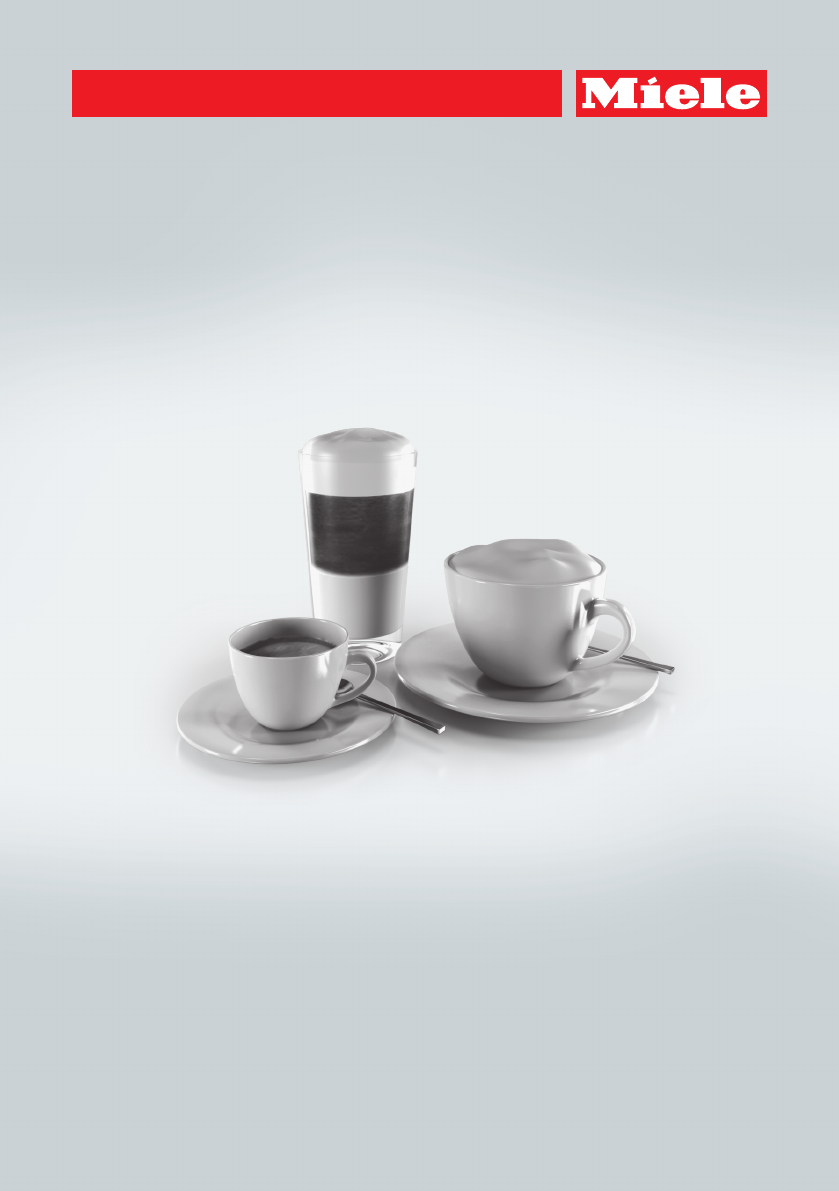
Operating instructions
Coffee machine
To avoid the risk of accidents or damage to the appliance it is essential
to read these instructions before it is installed and used for the first time.
en-GB M.-Nr. 10 793 020

Miele coffee
2
BLACK EDITION
N°1
Miele Black Edition N°1 coffee is a highly
harmonious and balanced blend comprising 4
hand-picked types of Arabica beans from the
highlands of South America.
Miele Coffee is available to order via the Miele
webshop, from Miele (see back cover for contact
details) or from your Miele dealer.
For the perfect coffee please set your coffee
machine to the following settings:
Drinks made
with Espresso
Drinks made
with coffee
Grinder
setting
4th position
from left
4th position
from left
Amount of
coffee
3rd position
from left
4th position
from left
Brewing
temperature
Medium Low
Pre-brewing Long Off
The procedure for setting the individual parameters
is given in the relevant chapters of this manual.
Portion sizes should be set to factory default
settings. If in doubt, please reset the portion sizes
back to the factory default settings.

Contents
3
Miele coffee ........................................................................................................... 2
Warning and Safety instructions.......................................................................... 6
Guide to the machine ......................................................................................... 15
Controls and display ........................................................................................... 16
Packaging material / Disposal of old machine ................................................ 17
Accessories ......................................................................................................... 18
Operation.............................................................................................................. 19
Before using for the first time ............................................................................ 20
Before using for the first time................................................................................ 20
Switching on for the first time ............................................................................... 20
Water hardness.................................................................................................... 22
Filling the water container.................................................................................. 23
Filling the coffee bean container ....................................................................... 24
Switching on and off ........................................................................................... 25
Adjusting the central spout to the correct cup height..................................... 26
Making drinks ...................................................................................................... 27
Making a coffee..................................................................................................... 27
Cancelling a drink.................................................................................................. 28
Two portions.......................................................................................................... 28
Coffee pot: making several cups of coffee one after the other ............................. 29
Making coffee drinks from ground coffee ............................................................. 29
Adding ready ground coffee............................................................................. 29
Dispensing hot water (CM5400,CM5500) ............................................................ 30
Making drinks using a profile (CM5400,CM5500) ................................................ 31
Making coffee with milk...................................................................................... 32
Using milk cartons or bottles ................................................................................ 32
Making drinks with milk......................................................................................... 33
Grinder setting..................................................................................................... 34

Contents
4
Amount of coffee, brew temperature and pre-brewing................................... 35
Amount of coffee................................................................................................... 35
Brewing temperature ............................................................................................. 35
Pre-brewing the coffee.......................................................................................... 35
Portion size .......................................................................................................... 36
Profiles.................................................................................................................. 38
Accessing profiles ................................................................................................. 38
Creating a profile ................................................................................................... 38
Selecting a profile.................................................................................................. 39
Changing a profile ................................................................................................. 39
Changing the name ............................................................................................... 39
Deleting a profile ................................................................................................... 39
Settings ................................................................................................................ 40
Opening the “Settings” menu................................................................................ 40
Changing and saving settings ............................................................................... 40
Possible setting options ........................................................................................ 41
Language............................................................................................................... 42
Timer: switch off after............................................................................................ 42
Eco mode .............................................................................................................. 42
Info (display information) ....................................................................................... 42
Locking the coffee machine (System lock) ....................................................... 42
Water hardness ..................................................................................................... 43
Display brightness................................................................................................. 43
Volume................................................................................................................... 43
Factory default setting........................................................................................... 43
Demo mode (Showroom programme)................................................................... 43
Cleaning and care ............................................................................................... 44
Cleaning intervals - Quick guide ........................................................................... 44
Unsuitable cleaning agents ................................................................................... 45
Cleaning by hand or in the dishwasher ................................................................. 46
Waste container, drip tray and drip tray cover ...................................................... 47
Cleaning the water container ................................................................................ 48
Central spout with integrated cappuccinatore ...................................................... 48
Milk pipework ........................................................................................................ 50
Bean container and ground coffee chute.............................................................. 50
Cleaning the housing............................................................................................. 51
Maintenance programmes..................................................................................... 51
Opening the “Maintenance” menu ...................................................................51
Rinsing the machine.............................................................................................. 52
Rinsing the milk pipework ..................................................................................... 52

Contents
5
Degreasing the brew unit and cleaning inside ...................................................... 54
Descaling the machine ....................................................................................... 57
Transporting the machine................................................................................... 59
Evaporating the coffee machine............................................................................ 59
Packing the machine ............................................................................................. 59
Problem solving guide ........................................................................................ 60
Messages in the display........................................................................................ 60
Unusual performance of the coffee machine ........................................................ 63
Unsatisfactory results............................................................................................ 69
After sales service............................................................................................... 71
Contact in case of malfunction ............................................................................. 71
Warranty ................................................................................................................ 71
Saving energy ...................................................................................................... 72
Electrical connection .......................................................................................... 73
Installation............................................................................................................ 74
Dimensions .......................................................................................................... 75
Technical data...................................................................................................... 76

Warning and Safety instructions
6
This coffee machine complies with current safety requirements.
Improper use can, however, present a risk of both personal injury
and material damage.
To avoid the risk of accidents and damage to the machine, please
read these instructions carefully before using it for the first time.
They contain important notes on setting it up, as well as on its
safety, operation and maintenance.
Miele cannot be held liable for damage caused by non-compliance
with these Warning and Safety instructions.
Keep the instructions in a safe place and pass them on to any
future owner.

Warning and Safety instructions
7
Correct application
This coffee machine is intended for use in domestic households
and similar working and residential environments.
Examples of a working or residential environment include
– shops, offices and other working environments,
– small businesses, showrooms etc.,
– where the coffee machine is being used by customers in hotels,
motels, bed and breakfast and other similar establishments.
This coffee machine is not intended for outdoor use.
This coffee machine must not be used at altitudes above 2000m.
It must only be used as a domestic appliance to make espresso,
cappuccino, latte macchiato etc. Any other use is not permitted.
This coffee machine can only be used by people with reduced
physical, sensory or mental capabilities, or lack of experience and
knowledge, if they are supervised whilst using it, or have been
shown how to use it in a safe way and recognise and understand the
consequences of incorrect operation.

Warning and Safety instructions
8
Safety with children
Caution! Danger of burning and scalding on the dispensing
spouts.
Children's skin is far more sensitive to high temperatures than that
of adults.
Ensure children do not touch hot surfaces of the coffee machine or
place parts of their body under the dispensing spouts.
Install the coffee machine where it is out of the reach of children.
Children under eight years of age must be kept away from the
machine and the mains connection cable and plug/socket.
Children 8 years and older may only use the coffee machine
unsupervised if they have been shown how to use it safely and
recognise and understand the consequences of incorrect operation.
Please supervise children in the vicinity of the coffee machine and
do not allow them to play with it.
Young children must not be allowed to clean the coffee machine
unsupervised. Cleaning may only be carried out by children eight
years old and above under the supervision of an adult.
Remember that coffee and espresso are not suitable drinks for
children.
Danger of suffocation.
Packaging, e.g. plastic wrappings, must be kept out of the reach of
babies and children. Whilst playing, they could become entangled in
packaging or pull it over their head and suffocate.

Warning and Safety instructions
9
Technical safety
A damaged coffee machine is dangerous. Check it for any visible
damage before setting it up. Never attempt to use a damaged coffee
machine.
To avoid the risk of damage to the machine, make sure the
connection data (voltage and frequency) on the data plate
corresponds to the household supply, before connecting the
machine to the mains supply. Consult a qualified electrician if in any
doubt.
The electrical safety of this coffee machine can only be
guaranteed when correctly earthed. It is essential that this standard
safety requirement is met. If in any doubt please have the electrical
installation tested by a qualified electrician.
Reliable and safe operation of the coffee machine can only be
guaranteed if it is connected to the mains electrical supply.
Do not connect the machine to the mains electricity supply by a
multi-socket adapter or an extension lead. These are a fire hazard
and do not guarantee the required safety of the appliance.
The coffee machine must not be used in a non-stationary location
(e.g. on a ship).
Unplug the machine from the power supply immediately if you
notice any damage or smell scorching, for example.
Ensure that the mains connection cable cannot be pinched or
damaged by any sharp edges.
The mains connection cable should not hang down. Someone
could trip over it with the risk of injury and damage the machine.
Only use the coffee machine in rooms where the ambient
temperature is between +10°C and +38°C.

Warning and Safety instructions
10
Danger of overheating. Ensure that there is sufficient ventilation
around the coffee machine. Do not cover it with tea towels etc.
whilst it is in use.
If the coffee machine is positioned behind a kitchen furniture door,
it may only be used with the furniture door open. This will prevent the
formation of heat and humidity and subsequent damage to the
machine and/or furniture unit. Do not close the furniture door while
the coffee machine is in use. Ensure the coffee machine has cooled
down completely before closing the furniture door.
Protect the coffee machine from water and water spray. Do not
immerse the machine in water.
Repairs and other work by unqualified persons to the machine
and the connection cable could be dangerous. The manufacturer
cannot be held liable for unauthorised work. Repairs may only be
carried out by a Miele authorised service technician.
While the machine is under warranty, repairs should only be
undertaken by a Miele authorised service technician. Otherwise the
warranty is invalidated.
Miele can only guarantee the safety of the appliance when
genuine original Miele replacement parts are used. Faulty
components must only be replaced by genuine Miele original spare
parts.
The coffee machine must be disconnected from the electricity
supply during repair work.
Never open the outer casing of the machine. Tampering with
electrical connections or components and mechanical parts is highly
dangerous to the user and can cause operational faults or electric
shock.
Only use genuine original Miele accessories with this machine.
Using spare parts or accessories from other manufacturers will
invalidate the guarantee, and Miele cannot accept liability.

Warning and Safety instructions
11
Correct use
Danger of burning and scalding on the dispensing spouts.
The liquids and steam dispensed are very hot.
Keep well away from the area underneath the spouts when hot
liquids and steam are being dispensed.
Do not touch hot components.
Hot liquid or steam could spatter from the spouts. Ensure that the
central spout is clean and fitted correctly.
Water in the drip tray can also be very hot. Take care when
emptying it.
Please note the following regarding water:
– Only use cold, fresh tap water to fill the water container. Hot or
warm water or other liquids could damage the coffee machine.
– Change the water every day to prevent a build-up of bacteria.
– Do not use mineral water. Mineral water will cause serious
limescale deposits to build up in your machine and damage it.
– Do not use water from a reverse osmosis unit in this machine.
This would damage it.
Only fill the bean container with roasted espresso/coffee beans.
Do not fill the bean container with coffee beans which have been
treated with additives or with ground coffee.
Do not fill the bean container with any type of liquid.
Do not use green (unroasted) coffee beans or mixtures of coffee
beans which contain green coffee beans. Green coffee beans are
very hard and still contain a certain amount of residual moisture.
These can damage the coffee machine grinder as soon as grinding
begins.
Do not use coffee beans which have been treated with caramel,
sugar or other substances including sugary liquids. Sugar will
damage the coffee machine.

Warning and Safety instructions
12
Only fill the coffee chute with ground coffee beans.
Do not use any caramelised ready ground coffee. The sugar in the
coffee will stick to and block the brew unit of the coffee machine.
The cleaning tablets for degreasing the brew unit will not remove this
type of deposit.
Only use milk without additives. Additives in milk usually contain
sugar and this will stick to the milk pipework.
If using dairy milk make sure that it has been pasteurised.
Do not place any alcohol mixtures which are alight underneath the
central spout. The flames could ignite plastic components and cause
them to melt.
Do not use naked flames, e.g. a candle, on or near the coffee
machine. The coffee machine could catch fire with the risk of the fire
spreading.
The machine must not be used for cleaning objects.

Warning and Safety instructions
13
Cleaning and care
The coffee machine must be disconnected from the electricity
supply before cleaning or maintenance.
Clean the coffee machine daily, particularly before using for the
first time (see “Cleaning and care”).
All parts of the milk system need to be cleaned thoroughly and
regularly. Milk contains bacteria which proliferate rapidly with
inadequate cleaning.
Do not use a steam cleaner to clean this machine. Steam could
reach electrical components and cause a short circuit.
Descale the coffee machine regularly depending on the water
hardness level in your area. Descale the machine more frequently in
areas with very hard water. Miele cannot be held liable for damage
arising from insufficient descaling, the use of incorrect descaling
agent or the use of descaling agent which is not of the appropriate
concentration.
Degrease the brew unit regularly with Miele cleaning tablets.
Depending on the natural oil content of the coffee used, the brew
unit can become blocked quite quickly.
Used coffee grounds should be disposed of with the organic
rubbish or on the compost heap. Do not empty them down the sink,
as they could block it.

Warning and Safety instructions
14
For machines with stainless steel surfaces:
Do not use sticky notes, transparent adhesive tape, masking tape
or other types of adhesive on the stainless steel surfaces.
Stainless steel surfaces are susceptible to scratching. Even
magnets can cause scratches.

Guide to the machine
15
a
Lower panel with drip tray cover
b
Central spout with Cappuccinatore
and hot water spout
c
On/Off button
d
Controls and display
e
Water container
f
Bean container and ground coffee
chute
g
Grinder setting (behind the service
panel)
h
Brew unit (behind the service panel)
i
Park position for milk pipework
(behind the service panel)
j
Drip tray with lid and waste container
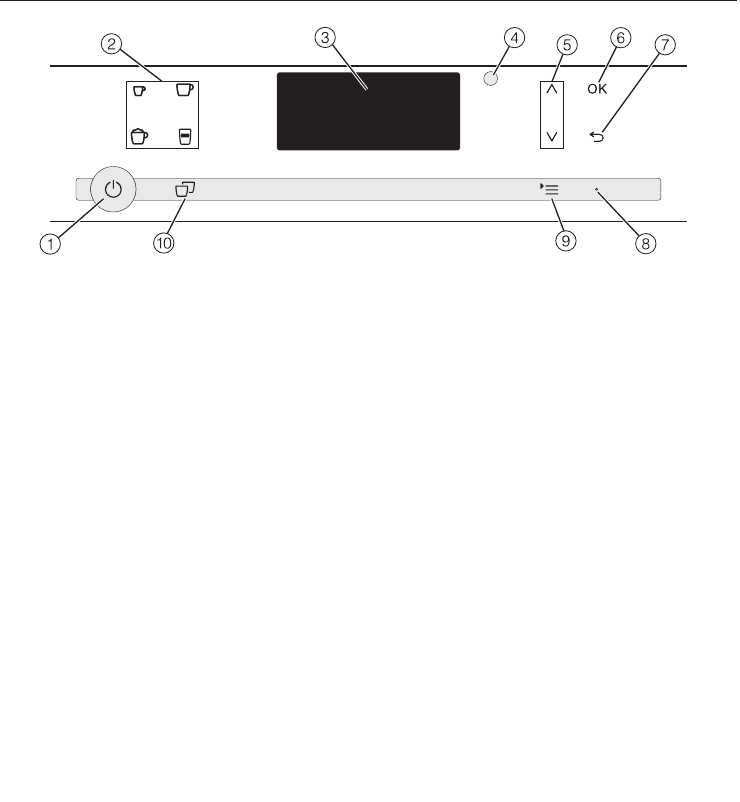
Controls and display
16
a
On/Off sensor
For switching the coffee machine on
and off
b
Drink sensors
Espresso
Coffee
Cappuccino or
Latte macchiato
c
Display
Shows information about the current
action or status
d
Optical interface
(for service technician use only)
e
Arrow sensors
For showing more selection options
in the display and for highlighting a
selection
f
OK
For confirming display messages and
saving settings
g
“Back”
For returning to the previous menu,
cancelling unwanted actions
h
LED
Flashes when the machine is
switched on and the display is in
energy saving mode
i
Menus
Other drinks
Profiles*
Maintenance
Parameters
Settings
j
Two portions
For dispensing two portions of a
drink
* CM5400,CM5500
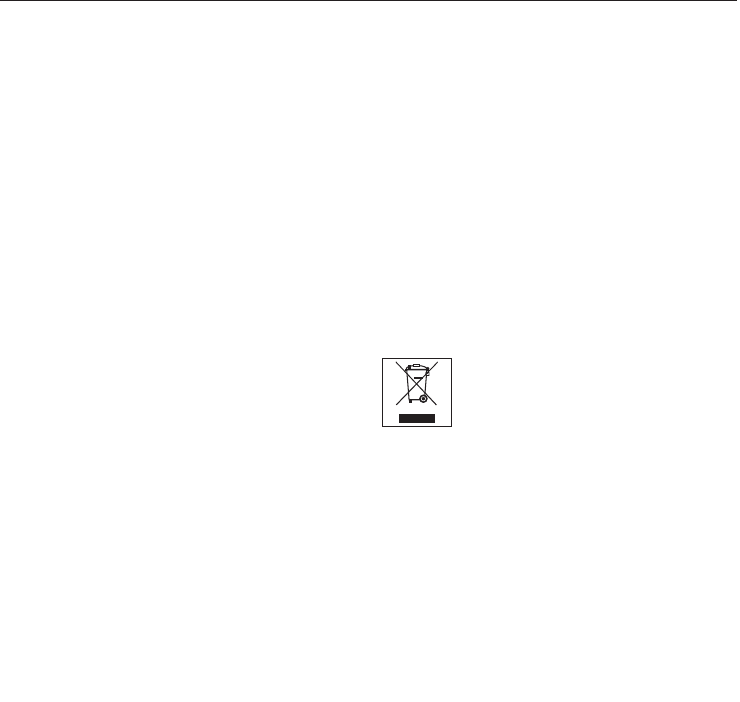
Packaging material / Disposal of old machine
17
Packaging material
The packaging material used protects
the machine during transportation.
Please retain the original box and
polystyrene pieces so that you can
pack the machine securely, should you
need to transport it in the future.
Disposing of your old
appliance
Electrical and electronic appliances
often contain valuable materials. They
also contain specific materials,
compounds and components, which
were essential for their correct function
and safety. These could be hazardous
to human health and to the environment
if disposed of with your domestic waste
or if handled incorrectly. Please do not,
therefore, dispose of your old appliance
with your household waste.
Please dispose of it at your local
community waste collection / recycling
centre for electrical and electronic
appliances, or contact your dealer or
Miele for advice. You are also
responsible by law for deleting any
personal data that may be stored on the
appliance being disposed of. Please
ensure that your old appliance poses no
risk to children while being stored prior
to disposal.

Accessories
18
These products and other useful
accessories can be ordered via the
Miele webshop, from Miele (see back
cover for contact details) or from your
Miele dealer.
Accessories supplied
– Starter set “Miele appliance care”
Various cleaning and care products,
such as Miele descaling tablets, are
supplied as standard. These vary
depending on model.
– Cleaning brush
for cleaning the milk pipework
Optional accessories
Miele accessories and cleaning and
conditioning products are available for
your coffee machine.
– Microfibre cloth
for removing finger marks and light
soiling
– Cleaning agent for milk pipework
for cleaning the milk system
– Cleaning tablets
for degreasing the brew unit
– Descaling tablets
for descaling the water pipework
– Stainless steel milk flask MB-CM
for keeping milk cool for longer
(capacity 0.5 litres)
– CJ JUG coffee flask
Vacuum flask for coffee or tea
(capacity 1l)
– Miele Black Edition N°1
A blend of 4 hand-picked types of
Arabica beans from the highlands of
South America.

Operation
19
To operate the coffee machine, touch
the sensors with your finger.
An audible signal is generated each
time a sensor is touched. You can
adjust the volume of the signal tones
or switch the tones off (see “Settings –
Volume”).
When the following appears in the
display, you are in the drinks menu:
Miele
Select drink
To make a drink, touch one of the
drinks sensors.
Touch, to open the Other drinks
menu. This includes drinks such as
Ristretto and Caffè Latte.
Selecting a menu and
navigating within a menu
To select a menu, touch the relevant
sensor. You will then be able to start an
action or change settings in the menu.
A bar on the right-hand side of the
display indicates that further options or
text are available. Use the arrow
sensors to view them.
The setting which is currently selected
will have a tick beside it.
To select an option, touch the arrow
sensors until the option you want is
highlighted.
Touch OK to confirm your selection.
Exiting a menu or cancelling an
action
To exit the current menu, touch.
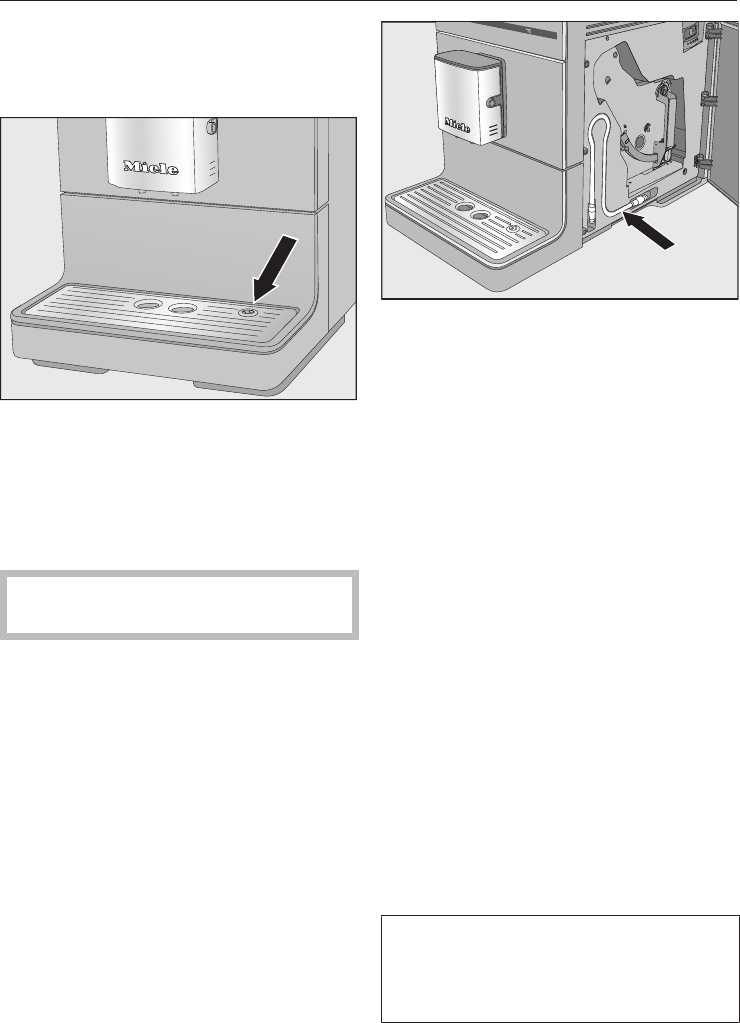
Before using for the first time
20
Before using for the first time
Remove any protective foil and notes
from the machine.
Remove the protective foil from the
drip tray cover and place the drip tray
cover into the lower panel.
Place the coffee machine on a level
flat surface that is not sensitive to
water (see “Installation”).
Clean the machine thoroughly before
filling it with water and coffee beans.
Insert the plug of the coffee machine
into the socket.
Remove the water container and fill it
with fresh, cold tap water. Only fill the
container up to the “max.” mark and
then push it back into the machine.
Take the lid off the coffee bean
container, fill it with roasted coffee
beans and replace the lid.
Tip: The milk pipework can be stored
behind the service panel when not in
use.
Switching on for the first time
Touch the On/Off sensor.
The welcome message Miele -
Willkommen will appear in the display
briefly.
Use the arrow sensors to
highlight the required language.
Touch OK.
Then select the country if necessary
and touchOK.
The setting is now saved.
The coffee machine is now set up for
use. It will heat up and rinse the
pipework. Water from the rinse process
will come out of the central spout.
Rinse the milk pipework (see “Rinsing
the milk pipework”) before making
drinks with milk for the first time.
Please note that the full aroma of the
coffee and typical crema will not
develop fully until several coffees have
been made.

Before using for the first time
21
For the first coffee drinks, a larger
quantity of coffee beans is ground and
powder from the coffee grounds may
adhere to the cover of the drip tray.

Water hardness
22
The water hardness level indicates how
much calcium is dissolved in the water.
The higher the calcium content, the
harder the water, and the harder the
water, the more often the coffee
machine will need to be descaled.
The coffee machine measures the
amount of water used and steam made.
Depending on the level of water
hardness set, more or fewer drinks can
be dispensed before the machine
needs to be descaled.
Programme the coffee machine to the
water hardness level of your area so
that it functions correctly and does not
get damaged. A prompt to descale the
machine will then appear in the display
at the correct time.
Contact your local water supplier to find
out your local water hardness range if
necessary.
The machine is programmed ex-works
to hardness level 3.
The machine has four programmable
levels:
°dH mmol/l ppm
(mg/l CaCO
3
)
Setting
0–8.4 0–1.5 0–150 Soft 1
8.4–14 1.5–2.5 150– 250 Medium 2
14–21 2.5–3.7 250–375 Hard 3
>21 > 3.7 > 375 Very hard
4
* The hardness level shown in the display may
differ from the hardness level in your area. You
must follow the values in the chart to set your
machine to your local hardness level.
Setting the water hardness
level
Touch .
Select Settings with the arrow
sensors and touch OK.
Select Water hardness and touch OK.
Select the hardness level you want
and then touch OK.
The setting is now saved.
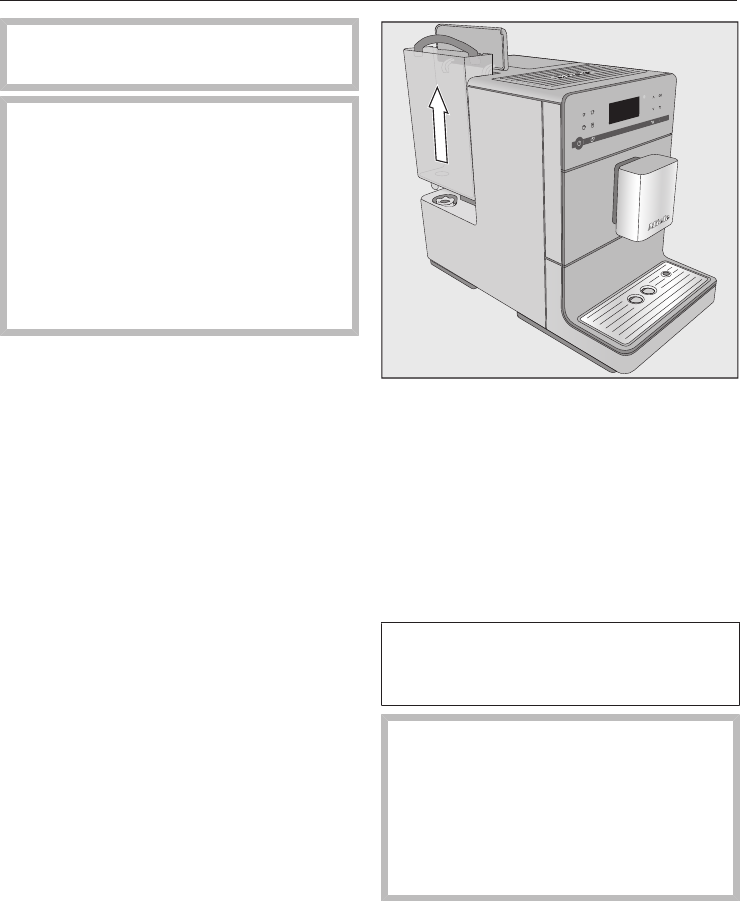
Filling the water container
23
Change the water every day to
prevent a build-up of bacteria.
Only use cold, fresh tap water to fill
the water container.
Hot or warm water or other liquids
can damage the coffee machine.
Do not use mineral water. Mineral
water will cause serious limescale
deposits to build up in your machine
and damage it.
Open the lid on the left hand side of
the coffee machine.
Pull the water container upwards and
out.
Fill the water container with fresh,
cold tap water up to the “Max.” mark.
Replace the water container and
close the lid.
Make sure that the water container
handle is on the right so that the lid
can close properly.
If the water container sits a little too
high or at an angle, check that it is
fitted correctly or whether the
surface that it sits on is soiled. Water
could leak. If necessary clean the
surface that the water container sits
on.
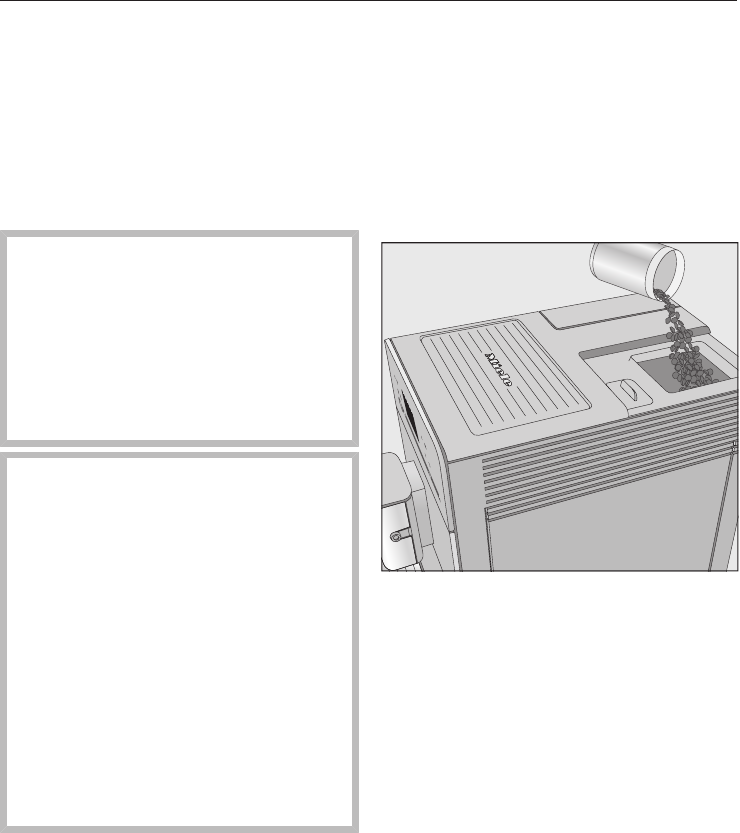
Filling the coffee bean container
24
Fill the coffee bean container with
roasted coffee or espresso beans if you
want to use freshly ground coffee beans
for each cup of espresso or coffee.
Alternatively, you can make coffee or
espresso with ready ground coffee (see
“Making coffee or espresso using ready
ground coffee”).
Warning. Risk of damage to the
grinder.
Only put roasted coffee or espresso
beans in the container. Anything
else, including ground coffee, will
damage the grinder.
Do not fill the bean container with
any type of liquid.
Warning. Sugar will damage the
coffee machine.
Do not use coffee beans that have
been treated with sugar, caramel or
other substances and do not put
liquids containing sugar in the coffee
bean container.
Do not use green (unroasted) coffee
beans or mixtures of coffee beans
which contain green coffee beans.
Green coffee beans are very hard
and still contain residual moisture.
These can damage the coffee
machine grinder as soon as grinding
begins.
Tip: You can use a nut or seed grinder
to grind green coffee beans. These
types of grinder generally have a
rotating stainless steel blade. You can
then add the ground green coffee one
portion at a time to the ground coffee
chute and make the desired coffee
drink (see “Making espresso and coffee
using ready ground coffee”).
Take the lid off the coffee bean
container.
Fill the container with roasted coffee
beans.
Replace the lid.

Switching on and off
25
Switching the coffee machine
on
Touch the On/Off sensor.
The appliance heats up and rinses the
pipework. Hot water will run out of the
central spout.
When Select drink appears in the display,
you can make drinks.
If the coffee machine is already at
operating temperature, rinsing will not
take place.
If you do not touch any sensors or run
any maintenance programmes, the
display will switch itself off after approx.
7minutes to save energy.
The right-hand LED will flash on and off
as long as the machine is switched on.
Touch any one of the sensors to wake
the machine up again to make a
drink.
Switching the coffee machine
off
Touch the On/Off sensor.
If the coffee machine has been used for
making a drink it will rinse itself before
switching off.
If you have made a drink using milk,
Place milk pipe in drip tray will appear in
the display.
Insert the end of the milk pipe into the
aperture in the drip tray, then touch
OK.
If the milk system is not rinsed out
before switching off, it will have to be
rinsed the next time the machine is
switched on.
Switching off for longer
periods of time
If the coffee machine is not going to be
used for a longer period of time, e.g. if
you are going on holiday:
Empty the drip tray, the waste
container and the water container.
Clean all parts thoroughly, including
the brew unit.
Switch the machine off and withdraw
the plug to disconnect it from the
power supply.
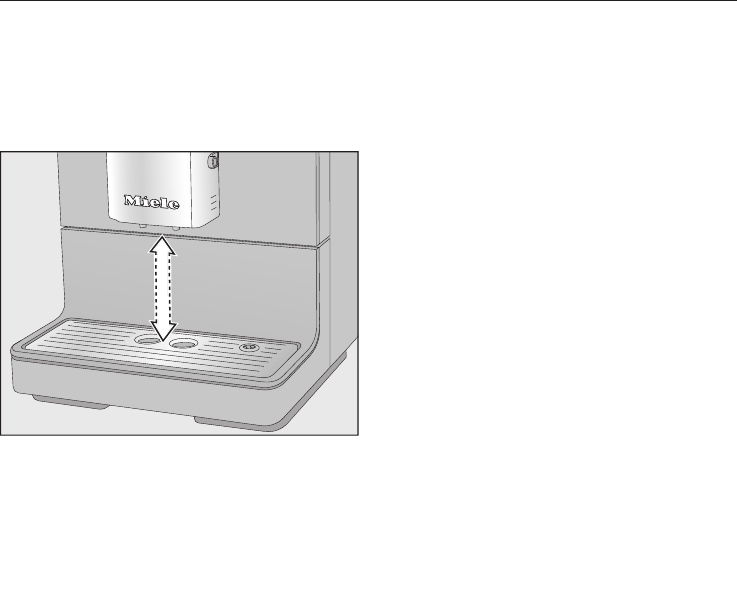
Adjusting the central spout to the correct cup height
26
You can adjust the central spout to suit
the height of the cup you are using so
that the coffee or espresso will not cool
down as quickly and the crema will
have a better consistency.
Pull the central spout down until it is
at the same level as the rim of the
cup.
Alternatively, push the central spout
up until there is enough room to fit a
larger cup or mug underneath.
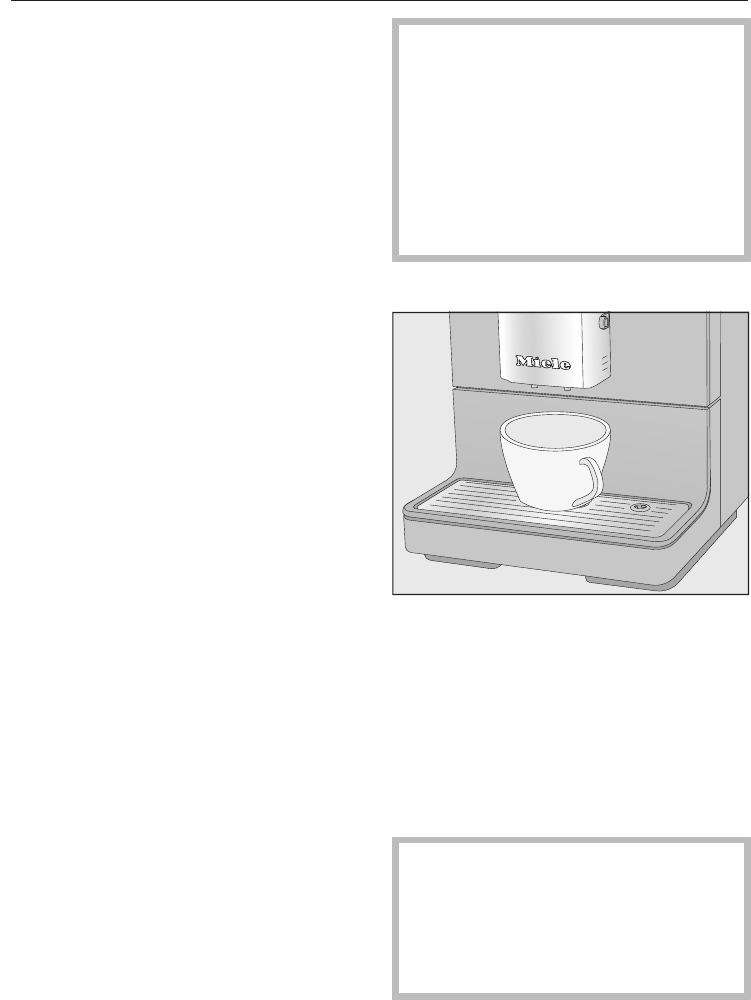
Making drinks
27
The following drinks with milk can be
made:
– Espresso. This is a strong,
aromatic coffee with a thick hazelnut
brown coloured layer of froth - known
as the crema - on top.
When making espresso, use
espresso roast coffee beans.
– Coffee. This differs from espresso
by the increased amount of water
and the roast of the beans.
Use coffee beans of the correct roast
to make coffee.
– Long coffee is a coffee with
considerably more water.
The spouts present a danger of
burning or scalding.
The liquids and steam dispensed are
very hot.
Keep well away from the area
underneath the spouts when hot
liquids and steam are being
dispensed.
Do not touch hot components.
Making a coffee
Place a cup under the central spout.
Select a drink:
– Espresso
– Coffee
– Go to Other drinks under for:
Ristretto or Long coffee
Dispensing will start.
To ensure that any coffee residues
from the factory testing process are
removed from the brewing system,
please throw away the first two cups
of coffee when using the coffee
machine for the first time.
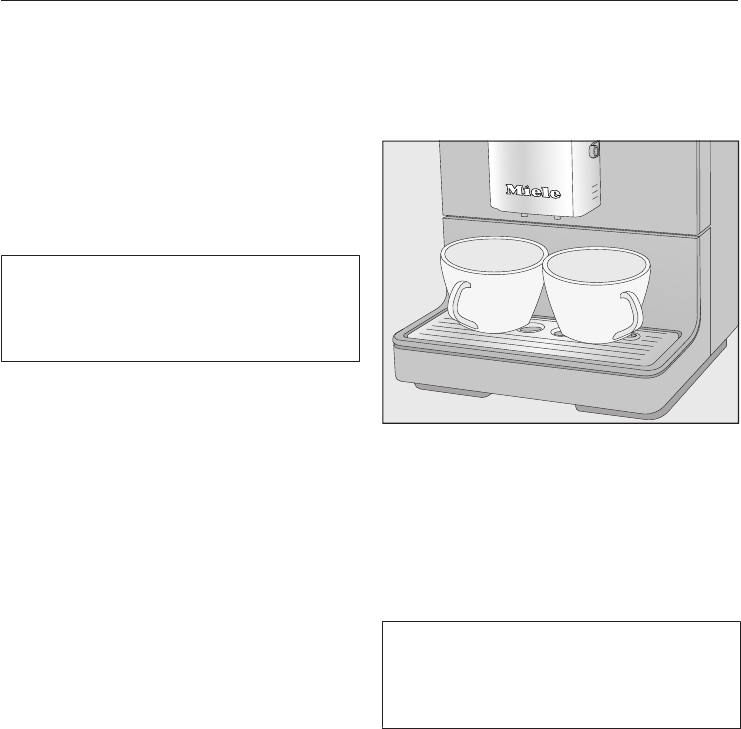
Making drinks
28
Cancelling a drink
To cancel making a drink, touch the
drinks sensor or for drinks from
Other drinks again.
The machine will stop dispensing.
Tip: You can cancel making a drink by
touching OK as soon as Stop appears in
the display.
When making coffee with milk or two
portions of a drink you can cancel
each stage individually by touching
OK.
Two portions
You can dispense two portions into one
cup or dispense two portions into two
cups at the same time.
To fill two cups at the same time,
place a cup under each coffee spout.
Touch .
Select a drink.
Two portions of the desired drink will be
dispensed from the central spout.
If, after a while, you have not touched
any of the drink sensors, the “Double
portion” option will revert back to
single portions.

Making drinks
29
Coffee pot: making several
cups of coffee one after the
other
You can make several cups of coffee
one after the other automatically with
the Coffee pot function (max. 0.75litre),
e.g. to fill a coffee pot. Up to six cups
can be made in this way.
You can use the Coffee pot function
twice in a row. After this, the coffee
machine needs a cooling down time of
one hour in order to avoid it being
damaged.
Place a sufficiently large container
under the central spout.
Touch .
Select Other drinks.
Touch the arrow sensors
repeatedly until Coffee pot is
highlighted.
Touch OK.
Touch the arrow keys repeatedly
until the desired number of cups (3 to
6) is highlighted. Touch OK.
Follow the instructions in the display.
Each portion of coffee will be brewed
and dispensed individually. You can
follow the process in the display.
Cancelling Coffee pot
Touch .
Coffee pot dispensing will stop.
Tip: A stainless steel vacuum flask is
available as an optional accessory from
Miele for the “Coffeee pot” function.
The CK JUG vacuum flask is available
to order via the Miele webshop, from
Miele (see back cover for contact
details) or from your Miele dealer.
Making coffee drinks from
ground coffee
To make drinks using ready ground
coffee, add a portion of ground coffee
to the ground coffee chute.
This allows you to make a decaffeinated
coffee, if the bean container is already
filled with regular coffee beans for
example.
Only one portion can be made at a time
when using ready ground coffee or
espresso.
Place a maximum of 12g in the
ground coffee chute. If too much is
added, the brew unit will not be able
to process the coffee.
Adding ready ground coffee
The coffee machine will use all the
ground coffee which has been added to
the chute to make the next coffee.
Touch and then select Other drinks.
Select Ground coffee with the arrow
sensors and touch OK.
Add ground coffee and select drink will
appear in the display.
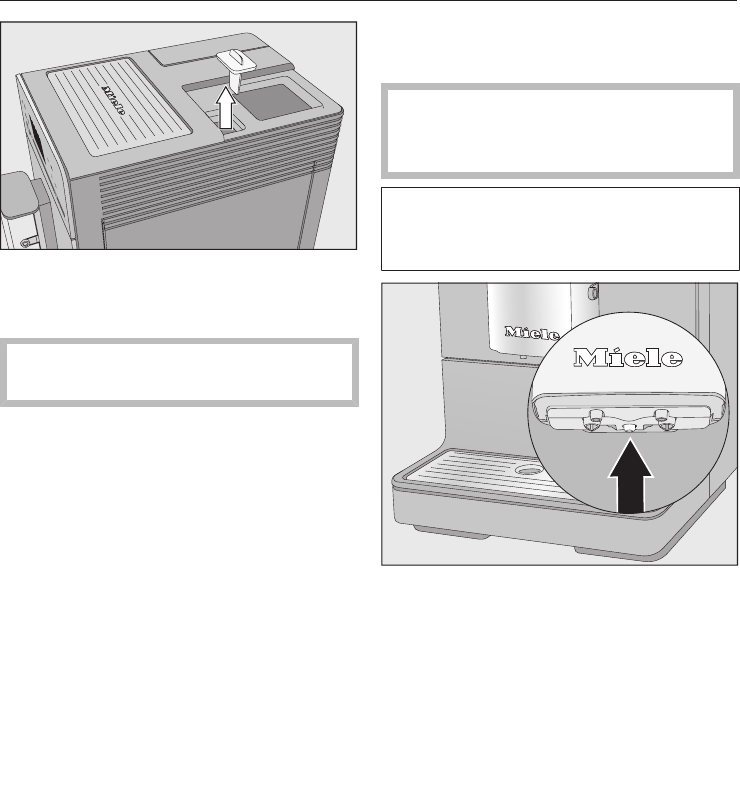
Making drinks
30
First take the lid off of the coffee
bean container and then take the
cover off the ground coffee chute.
Place a maximum of12g in the
ground coffee chute.
Replace the cover to the ground
coffee chute after adding the ground
coffee.
Replace the lid on the coffee bean
container.
Place a cup under the central spout.
Select a drink.
The coffee will now be made.
Dispensing hot water
(CM5400,CM5500)
Caution! Danger of burning and
scalding on the central spout. Water
coming out of the spout is very hot.
Please note that the water dispensed
is not hot enough for making black
tea.
Place a suitable container centrally
underneath the central spout.
Touch and then select Other drinks.
Select Hot water and touch OK.
Hot water will run into the container
under the hot water spout.
To stop dispensing early, touchOK.

Making drinks
31
Making drinks using a profile
(CM5400,CM5500)
You can tailor drinks to your personal
preferences and save them in a profile.
If you have already created your own
profile (see “Profiles”), you can select
this to make a drink according to your
own preferences.
Touch and then select Profiles.
Select the profile you want and touch
OK.
The name of the selected profile will
appear in the top of the display.
You can now make your drink.
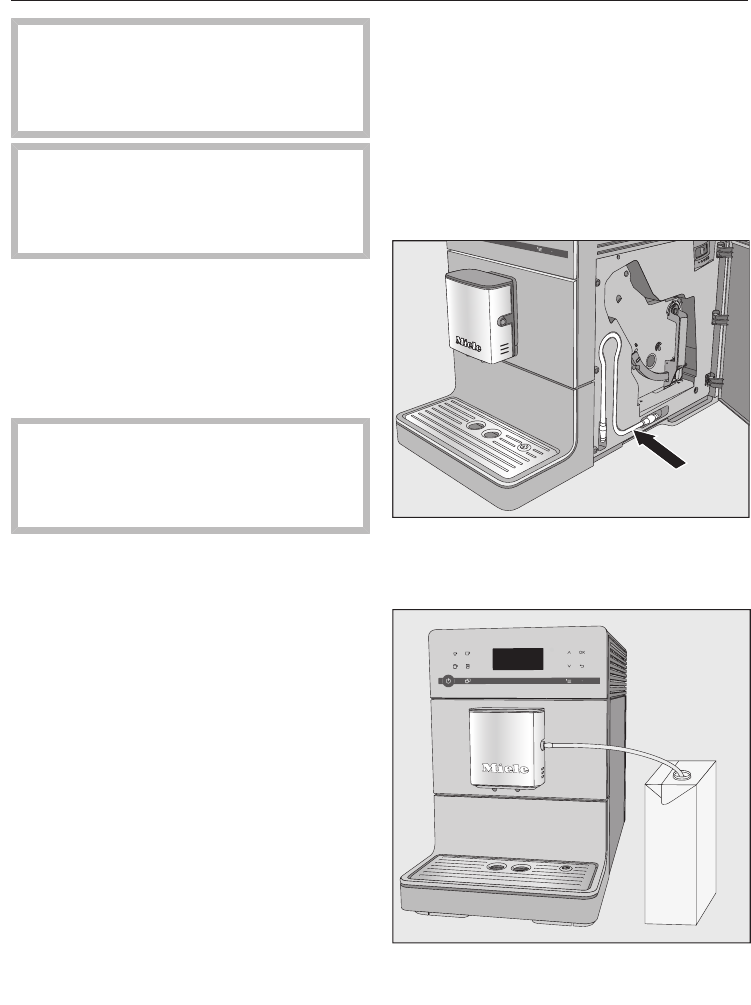
Making coffee with milk
32
Caution. Danger of burning and
scalding from the central spout.
Liquids and steam dispensed from
the spouts will be very hot.
Do not use milk with additives. Most
additives contain sugar which will
stick to the milk pipework and
damage the machine.
As soon as you select a drink
containing milk the machine will start to
heat up. The milk will be drawn up into
the central spout where it is heated by
steam and also frothed for drinks
requiring milk froth.
If you have not made any milk drinks
for a while, rinse the milk system
through before making the first drink.
This will flush out any bacteria.
The following drinks with milk can be
made:
– Cappuccino consisting of approx.
2/3 milk froth and 1/3 espresso.
– Latte macchiato consisting of 1/3
each of hot milk, milk froth and
espresso.
– Caffè latte consisting of hot milk
and espresso.
Hot milk or milk froth can also be
made.
Tip: Using cold cow's milk (<10°C)
with a protein content of at least 3 %
will produce the perfect milk froth.
You can select milk with a fat content
according to preference. With whole
milk (at least 3.5% fat), the milk froth
will be slightly creamier.
Using milk cartons or bottles
The milk tube for cartons and other
suitable containers is located behind
the service panel.
Connect the milk tube to the aperture
in the central spout.

Making coffee with milk
33
Place a container with sufficient milk
in it beside the coffee machine.
Place the end of the milk tube in the
container. Make sure that it is
sufficiently immersed in the milk.
Tip: The Miele stainless steel flask
keeps milk cool for longer. Good milk
froth can only be made with cold milk (<
10°C).
The MB-CM milk flask is available to
order via the Miele webshop, from Miele
(see back cover for contact details) or
from your Miele dealer.
Making drinks with milk
Place a suitable container underneath
the central spout.
Select a drink:
– Cappuccino
– Latte macchiato
– Go to Other drinks in the menu to
select:
Caffè latte, Hot milk and Milk froth
The drink will now be made.
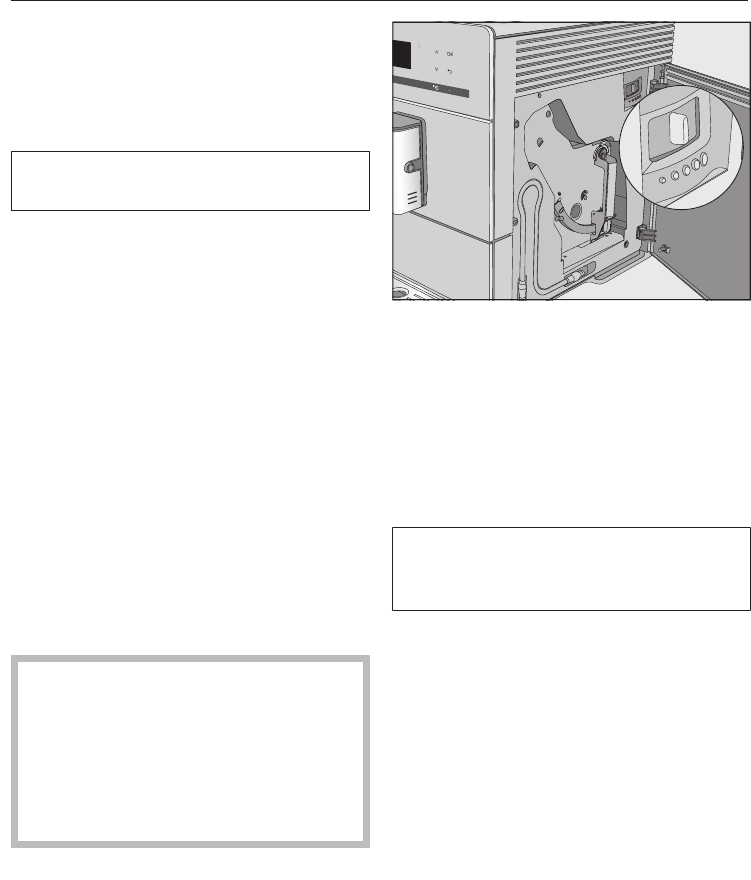
Grinder setting
34
When the beans are ground correctly,
the coffee or espresso will flow evenly
into the cup with a good crema.
The crema should have an even nut-
brown colour.
The grinder setting you select will be
used for all coffee drinks.
There are various ways to tell whether
the coffee grinder is set correctly.
The coffee has been too coarsely
ground if:
– Espresso or coffee flows into the cup
too quickly.
– The crema is very pale and uneven.
Set a finer grinder setting.
The coffee has been too finely ground
if:
– Espresso or coffee only trickles into
the cup.
– The crema is dark brown.
Set a coarser grinder setting.
To avoid damaging the grinder,
please note the following:
Only adjust the grinder one setting at
a time.
Grind the coffee beans again if you
want to adjust the grinder to the next
setting.
Open the service panel.
Push the slide control a maximum of
one setting to the left (for finer
grinding) or to the right (for coarser
grinding).
Close the service panel.
Make one cup of coffee.
Adjust the grinder setting again.
The altered grinder setting will not be
used until after the second coffee has
been dispensed.

Amount of coffee, brew temperature and pre-brewing
35
You can set the amount of coffee, the
brewing temperature and pre-brewing
for each drink individually. To do this,
first select the drink from the
Parametersmenu and then adjust the
drink parameters.
Touch and then select Parameters.
Select the drink and touch OK.
The current settings for the amount of
coffee, brewing temperature and pre-
brewing will be displayed for this drink.
Select Amount of coffee, Brew
temperature or Pre-brewing.
Select the setting you want and
touchOK.
The setting is now saved.
Amount of coffee
The coffee machine can grind and brew
6-14 g of coffee beans per cup. The
greater the quantity, the stronger the
coffee.
There are various ways to tell whether
the amount of coffee is set correctly:
The amount of coffee is too low if
– Espresso or coffee flows into the cup
too quickly,
– the crema is very pale and uneven,
– the espresso or coffee lacks body.
Increase the amount of coffee so that
more ground coffee is brewed.
The amount of coffee is too high, if
– espresso or coffee flows into the cup
very slowly,
– the crema is dark brown,
– the espresso or coffee tastes bitter.
Decrease the amount of coffee so that
less ground coffee is brewed.
Tip: If the coffee is too strong for you or
it tastes bitter, try a different type of
bean.
Brewing temperature
The ideal brewing temperature will
depend on
– the type of coffee being used,
– whether an espresso or a coffee is
being made, and
– the air pressure in the region.
Tip: Not all types of coffee tolerate high
temperatures. Several types are
sensitive to high temperatures, resulting
in an impaired crema and taste.
Pre-brewing the coffee
When the pre-brewing function is
switched on, the freshly ground coffee
is first moistened with a little hot water.
Then the remaining water is forced
through the moistened coffee at high
pressure. This helps release the flavour
of the coffee.
You can set pre-brewing for a short or
long length of time, or deselect “ Pre-
brewing ” altogether.
The machine is supplied with the “Pre-
brewing” function switched off.

Portion size
36
The flavour of the coffee produced
depends not only on the type of coffee,
but also on the amount of water used.
You can programme the amount of
water for all coffee drinks and hot water
to suit the size of your cups and the
type of coffee you are using. This does
not alter the amount of coffee used.
For coffee drinks that use milk you can
also set the amount of milk or milk froth
to be dispensed with these drinks.
Additionally, you can set the portion
sizes for hot milk and milk froth alone.
A maximum portion size can be
programmed for each type of drink. The
coffee machine stops making coffee
once this portion size has been
reached. The maximum possible
portion size is then saved by the
machine for this type of drink.
If the water container becomes empty
whilst making a drink, the machine will
stop programming the portion size.
The portion size will not be saved.
There are two ways of initiating the
programming of the portion size:
– by touching the drink sensor when
you are making a coffee; or
– by selecting Portion size in the
Parameters menu.
CM5400,CM5500: The changed
portion size is always saved in the
current profile. The name of the current
profile is shown in the top left of the
display.
Cancelling portion size programming
Touch the drinks sensor or for
drinks from Other drinks again.
Changing the portion size
while making a drink
You can change and save the portion
size for Espresso, Coffee,
Cappuccino and Latte macchiato
while making these drinks.
Place a cup under the central spout.
Touch the sensor for the drink you
want until Change appears in the
display.
An audible tone will sound as soon as
portion programming starts. (As long
as the volume has been set for the
audible tones - see volume).
The desired drink will be made and Save
will appear in the display.
When the cup is filled up to the level
you want, touchOK.
If you want to change the portion size
for coffee made with milk, the
ingredients which make up the drink will
be saved one after the other while the
drink is being made.
When the quantity for each ingredient
reaches the level you want, touchOK.
The programmed mix of ingredients and
portion sizes will now be dispensed
every time that particular drink is
selected.

Portion size
37
Changing the portion sizes in
the Parametersmenu
You can only change the portion sizes
for Long coffee, Caffè Latte, hot
milk and milk froth via the
“Parameters” menu.
Place a suitable container underneath
the central spout.
Touch and then select Parameters.
Select the drink you want.
Select Portion size and touch OK.
Now proceed as for changing the
portion size while making a drink.

Profiles
38
(CM5400, CM5500)
In addition to the Miele profile, you can
enter two individual profiles to cater for
different tastes and preferences.
In each profile you can adjust the
settings for individual drinks (portion
size, amount of coffee, brewing
temperature and pre-brewing).
The name of the current profile is
shown in the top left of the display.
Accessing profiles
Touch and then select Profiles.
You can now create a profile.
If you have already created a profile in
addition to the Miele profile, you have
the following options:
– Select profile from the profiles which
are already allocated.
– Change profile to programme the
coffee machine so that it changes
back to the Miele standard profile
automatically after each drink is
dispensed or so that it retains the
most recently selected profile.
– Change name if you want to alter the
name of a profile.
– Delete profile if you want to delete a
profile.
Touching takes you back to the
previous menu. Touching takes you
back to the drinks menu.
Creating a profile
Select Create profile with the arrow
sensors and touch OK.
Letters will appear in the display that
you can select with the arrow sensors.
You can use the arrow sensors to select
numbers, upper case and lower case
letters.
Touch the arrow sensors to
select the first character and then
touchOK.
The character you have chosen will
appear in the top line of the display.
Repeat the process until the name
required appears in the top line of the
display.
Tip: If you make a mistake you can
delete the last character with the
sensor.
When you have finished entering a
name and want to save it,
use the arrow sensors to
highlight the tick and touch OK.
If you do not want to save your entry:
touch until all characters have
been deleted and the previous menu
appears in the display.
The last created profile is selected as
the current profile.

Profiles
39
Selecting a profile
This option is only possible if a profile
has been allocated in addition to the
Miele standard profile.
Select Select profile with the arrow
sensors and touch OK.
Select the profile with the arrow
sensor and touchOK.
The name of the current profile is
shown in the top left of the display.
Changing a profile
You can programme the coffee machine
so that it changes back to the Miele
profile automatically after each drink
has been dispensed, so that the Miele
profile is always active when the
machine is switched on or so that it
retains the most recently selected
profile.
Select Change profile and then touch
OK.
You now have the following options:
– Manually: The currently selected
profile will remain active until you
select another profile.
– After each use: The machine will
change back to the Miele profile
automatically after a drink is
dispensed.
– When switched on: Each time the
machine is switched on it will
automatically select the Miele profile
regardless of which profile was
selected before the machine was last
switched off.
Select the required option and touch
OK.
Changing the name
This option is only possible if a profile
has been allocated in addition to the
Miele standard profile.
Select Change name with the arrow
sensors and touch OK.
Now proceed as described in
“Creating a profile”:
– Select to delete a character,
– To enter new characters, highlight the
relevant character and confirm with
OK,
– Save the new name by selecting in
the display and touching OK.
Deleting a profile
This option is only possible if a profile
has been allocated in addition to the
Miele standard profile.
Select Delete profile with the arrow
sensors and touch OK.
Select the profile you wish to delete.
Select Yes and touch OK.
The profile will be deleted.

Settings
40
Opening the “Settings” menu
Touch .
Select Settings with the arrow
sensor and then touchOK.
You can now check or change the
settings.
Options which are currently selected
will have a tick next to them.
Touching takes you back to the
previous menu.
Touch if you want to go back to the
Select drink menu.
Changing and saving settings
Start in the Settings menu.
Select the setting you wish to change
with the arrow sensors.
Touch OK.
Use the arrow sensors to
highlight the required option.
Touch OK.
The setting is now saved.

Settings
41
Possible setting options
The factory default for each option has a * next to it.
Option Available settings
Language deutsch* English and other languages
Country
Timer Switch off after (0:30)*
Eco mode On* / Off
Info Number of drinks
– Total coffee drinks / Total no. of portions / Espresso /
Coffee / Cappuccino / Latte macchiato / Ristretto / Long
coffee / Caffè latte / Hot milk / Milk froth / Hot water
(CM5400, CM5500 only)
No. of uses until
– Descale the appliance / Degrease the brew unit
System lock On / Off*
Water hardness Soft
Medium
Hard*
Very hard
Display brightness Set the brightness
Volume Buzzer tones
Keypad tone
Showroom programme Demo mode (On / Off*)
Factory default Do not reset
Reset

Settings
42
Language
You can select the language (and
country variant of that language) for all
display text.
Tip: If you select the wrong language
by mistake, you can find the
“Language” option by following the flag
symbol .
Timer: switch off after
If none of the sensors have been
touched or no drink has been made, the
coffee machine will switch itself off after
30 minutes to save energy.
You can change this pre-setting using
the arrow sensors to a time of
between 15 minutes and 9 hours.
Eco mode
The Eco mode is an energy-saving
mode.
If Eco mode is switched on, the coffee
machine will heat up anew every time a
drink is made, so that making a drink
takes longer.
If Eco mode is switched off, the coffee
machine uses considerably more
energy. The coffee machine heats up
for dispensing the first drink after
switching on. After that the machine
remains heated up and drinks can be
dispensed without having to wait so
long.
A message regarding the altered energy
consumption will appear in the display.
Info (display information)
The Info option allows you to see the
number of portions made for each
drink.
You can also see whether more than
50portions can be dispensed before
the machine needs to be descaled or
before the brew unit needs to be
degreased (No. of uses until).
Tip: TouchOK to return to the previous
display.
Locking the coffee machine
(System lock)
You can lock the coffee machine to
prevent it being used without your
knowledge, by children, for example.
Overriding the system lock
While the message Press the OK button
for 6 seconds to unlock is in the display,
touch the OK sensor for 6 seconds.
As soon as you switch the coffee
machine off, the system lock will be
activated again and the coffee
machine is locked.

Settings
43
Water hardness
Information regarding water hardness is
given in the “Water hardness” chapter.
Display brightness
Change the display brightness using
the arrow sensors .
Volume
You can set the volume of buzzer and
sensor tones using the arrow
sensors.
Tip: To switch off the tones, touch the
arrow sensor, until no segments are
filled and Switched offappears.
Factory default setting
You can reset the coffee machine to its
factory default settings.
The number of drinks and the machine
status (No. of drinks until the machine
must be descaled, ... Degrease the
brew unit) cannot be reset.
Please refer to the “Possible setting
options” chart for the factory settings.
The following settings will not be
reset:
– Language
– Profiles and their drinks
Demo mode (Showroom
programme)
Do not activate this setting for
domestic use!
The coffee machine can be
demonstrated in the showroom using
theShowroom programme. In this mode
the machine lights up but drinks cannot
be made or actions taken.
If you activate the Demo mode, you
cannot switch the appliance off with
the On/Off sensor.
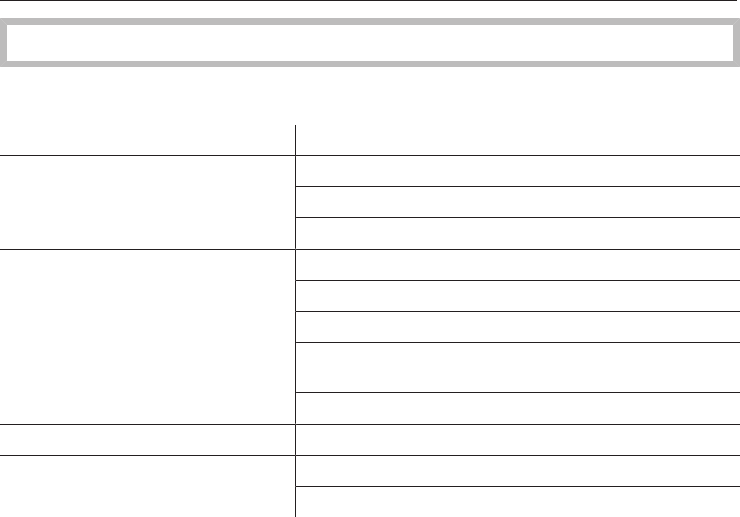
Cleaning and care
44
Clean the coffee machine regularly to avoid a build-up of bacteria.
Cleaning intervals - Quick guide
Recommended frequency What do I have to clean / maintain?
Daily
(at the end of the day)
Water container
Waste container
Drip tray and drip tray cover
Once a week
(more often if heavily soiled)
Central spout with integrated cappuccinatore
Brew unit
Area underneath the brew unit and the drip tray
Casing of the machine (especially important immediately
after descaling)
Milk pipework
Once a month Bean container and ground coffee chute
When prompted Degrease the brew unit (with 1cleaning tablet)
Descale the machine (with 1 descaling tablet)

Cleaning and care
45
Danger of burning and scalding
on hot components or by hot liquids.
Always allow the coffee machine to
cool down before cleaning it.
Caution: Water in the drip tray can be
very hot
Do not use a steam cleaner to
clean this machine. Steam could
reach the electrical components and
cause a short circuit.
It is important to clean the machine
regularly as the used coffee grounds
will soon go mouldy. Sour milk deposits
can block the milk pipework.
Unsuitable cleaning agents
All surfaces are susceptible to
scratching. Scratches on glass can in
some circumstances lead to
breakage. Contact with unsuitable
cleaning agents can alter or
discolour the external surfaces.
Ensure that any splashes of
descaling solution are wiped up
immediately.
To avoid damaging the surfaces, do not
use:
– cleaning agents containing soda,
ammonia, acids or chlorides
– solvent-based cleaning agents
– limescale removers
– stainless steel cleaning agents
– dishwasher cleaner
– glass cleaning agents
– oven cleaner
– abrasive cleaning agents, e.g.
powder cleaners and cream cleaners
– hard, abrasive brushes or sponges,
e.g. pot scourers, brushes or
sponges which have been previously
used with abrasive cleaning agents
– eraser blocks
– sharp metal scrapers
– steel wool or stainless steel wire
scourers
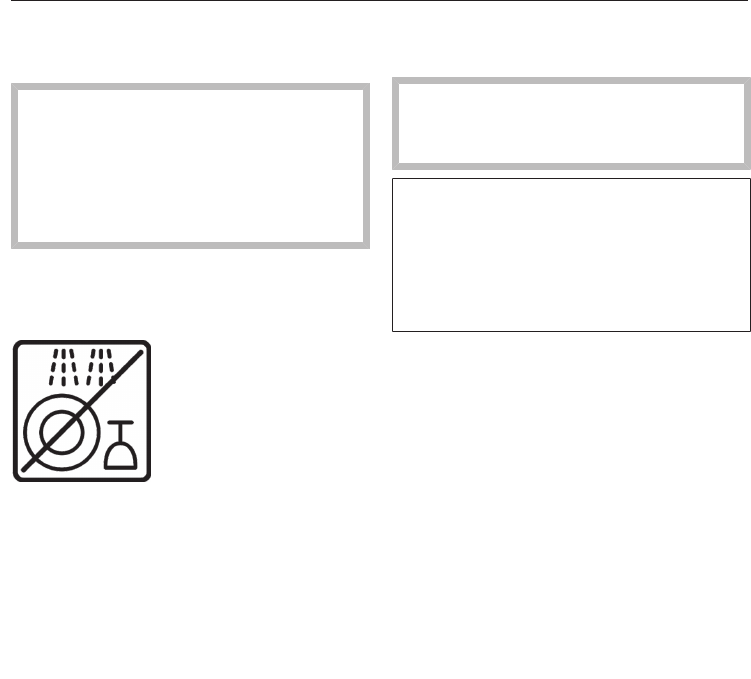
Cleaning and care
46
Cleaning by hand or in the
dishwasher
Please note that the brew unit is not
dishwasher safe.
Clean the brew unit by hand only
under warm running water. Do not
use washing-up liquid or any other
cleaning agent.
Most of the parts that can not be
washed in a dishwasher have a
pictogram on them.
The following must be cleaned by hand
only:
– Stainless steel central spout cover
– Brew unit
– Bean container lid
– Lower panel
The following components are
dishwasher safe:
The maximum temperature of the
dishwashing programme selected
must not exceed 55°C.
Contact with natural dyes such as
those found in carrots, tomatoes and
ketchup may discolour the plastic
parts in the dishwasher. This
discolouration does not affect the
stability of the parts.
– Drip tray and lid
– Drip tray cover
– Waste container
– Water container
– Central spout (without stainless steel
cover)
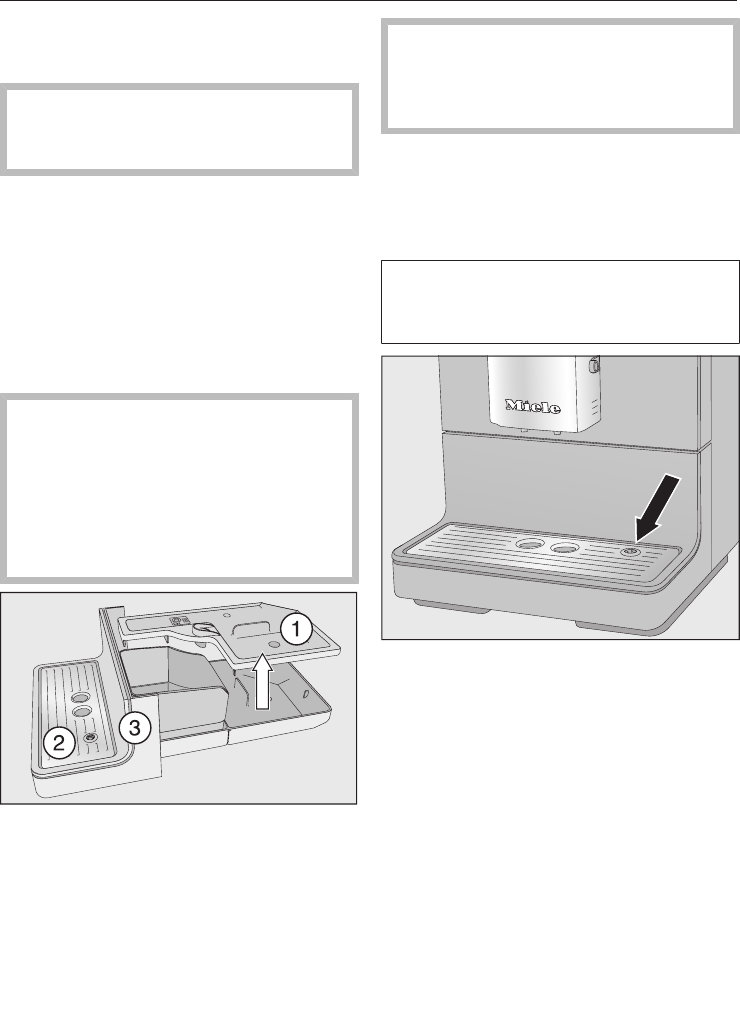
Cleaning and care
47
Waste container, drip tray and
drip tray cover
Clean the drip tray and waste
container every day to avoid
unpleasant smells and mildew.
The waste container is located in the
drip tray. Water from rinsing also
collects in the waste container.
A prompt will appear in the display
when the drip tray and/or the waste
container is full and needs to be
emptied. Empty the drip tray and the
waste container.
Danger of burning.
If the rinsing process has just
finished, wait a while before
removing the drip tray from the
machine. The water used for rinsing
will continue to run out of the coffee
spouts for a while.
Pull the drip tray carefully out of the
machine. Take the lid off.
Empty the drip tray and the waste
container.
Remove drip tray cover and lower
panel.
Clean all parts thoroughly.
Clean the lower panel by hand only
using hot water, a little washing up
liquid and a soft cloth.
All other parts are dishwasher-safe.
Clean the inside of the machine
underneath the drip tray.
Reassemble all parts and place the
drip tray back in the coffee machine.
Make sure the drip tray has been
pushed right into the machine as far
as it will go.
Make sure that the drip tray cover is
correctly fitted (see picture).
Clean the area under the coffee
machine. Water can get under the
machine when the drip tray is
removed.
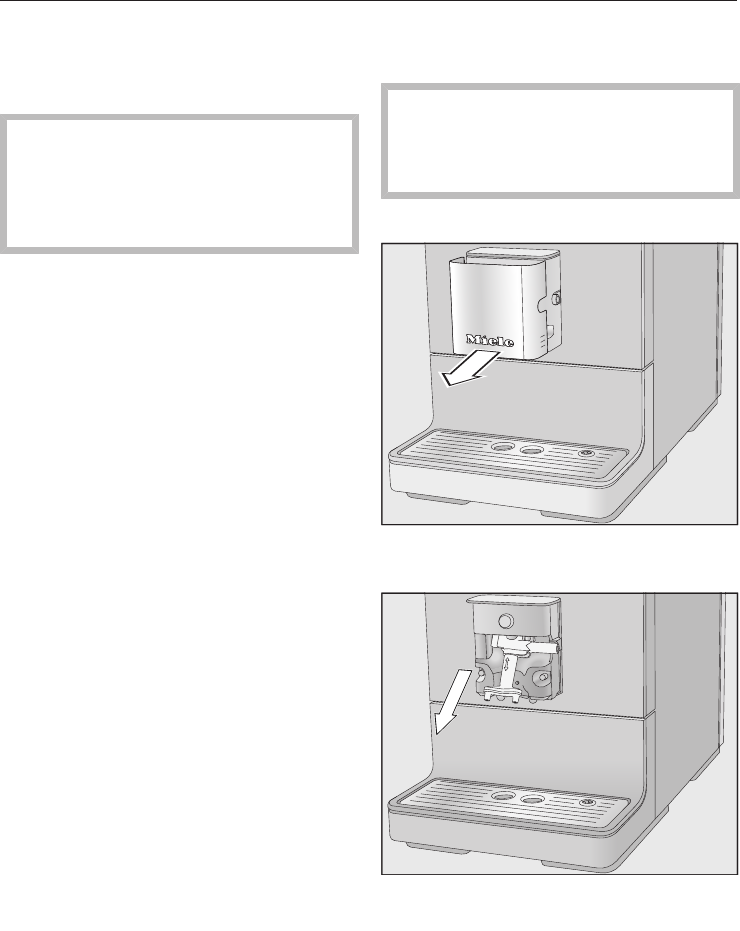
Cleaning and care
48
Cleaning the water container
Change the water every day to prevent
a build-up of bacteria.
Make sure that the valve, the
underside of the water container and
the surface the water container sits
on are clean. Otherwise, the water
container will not sit correctly.
Remove the water container.
Clean the water container in the
dishwasher or by hand using warm
water and a little washing-up liquid.
After cleaning, dry the water
container.
Carefully clean and dry the surface
the water container sits on, taking
special care to clean the recesses
properly.
Push the water container back into
the appliance.
Central spout with integrated
cappuccinatore
Clean the stainless steel central
spout cover by hand only using
warm water and a little washing-up
liquid.
All other parts are dishwasher-safe.
Pull the stainless steel cover forwards
and off.
Pull the dispensing unit down to
remove it.
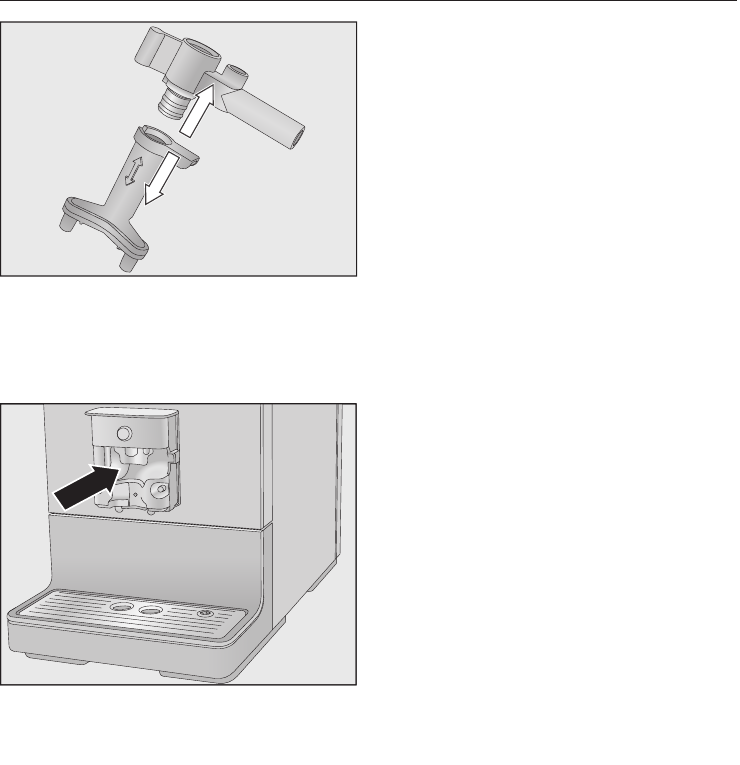
Cleaning and care
49
Release the upper section with the
holder for the milk pipework from the
dispensing spouts.
Clean all parts thoroughly.
Clean the surfaces of the central
spout and the dispensing spouts with
a damp cloth.
Clean any blockages in the milk
pipework under running water with the
special brush supplied:
Insert the brush in the pipework.
Move it back and forth until all milk
residue has been removed.
Reassemble the central spout
The dispensing unit is easier to
reassemble if the individual parts are
dampened with water beforehand.
Fit the dispensing unit back together.
Refit the dispensing unit onto the
central spout. Press firmly to ensure
the dispensing unit is securely fitted
without any gaps.
Replace the stainless steel cover and
connect the milk pipework.

Cleaning and care
50
Milk pipework
Ensure that all components in
which milk is transported are cleaned
carefully on a regular basis. Milk
naturally contains bacteria that
rapidly multiply if the milk pipework
is not cleaned properly. Soiling in the
appliance may be dangerous to
health.
The milk pipework must be cleaned at
least every 5 days.
There are two options for cleaning the
milk pipework:
– You can remove and dismantle the
central spout with its integrated
cappuccinatore and either wash it in
the dishwasher or by hand with hot
water and a little washing-up liquid
(see “Central spout with integrated
cappuccinatore”).
– Or you can clean the milk pipework
using the Clean milk pipework
maintenance programme together
with cleaning agent for milk pipework
(see “Maintenance programmes -
Cleaning the milk pipework”).
Tip: In addition to your weekly cleaning
routine we recommend carrying out the
alternative cleaning procedure once a
month. For example if you manually
clean the machine once a week, then
you should run the Clean milk pipework
maintenance programme once a month.
This combination will ensure that the
milk pipework is cleaned optimally.
Bean container and ground
coffee chute
Danger of injury from the grinder!
Switch off the machine and
disconnect it from the power supply
before cleaning the bean container.
Coffee beans contain oils which can
deposit on the walls of the bean
container and hinder the flow of the
beans. Therefore, clean the bean
container regularly with a soft cloth.
Open the bean container.
Remove any coffee beans.
Clean the bean container with a dry,
soft cloth.
The bean container can now be refilled.
If necessary, clean the ground coffee
chute:
Open the coffee chute and remove
any ground coffee residue.
Tip: Use a vacuum cleaner to remove
any coffee residues from the bean
container and the ground coffee chute.

Cleaning and care
51
Cleaning the housing
Remove any soiling immediately. If
soiling is not removed promptly, it
could cause the surface to alter or
discolour.
Make sure that water cannot get
behind the display.
The surfaces are all susceptible to
scratching and discolouration if
unsuitable cleaning agents are used.
Ensure that any splashes of
descaling solution are wiped up
immediately.
Switch the coffee machine off.
Clean the front with a clean soft
sponge and a solution of warm water
and a little washing-up liquid. Dry all
parts with a soft cloth.
Tip: You can also clean the appliance
front with the Miele all purpose
microfibre cloth.
Maintenance programmes
The coffee machine has the following
maintenance programmes:
– Rinse the machine
– Rinse the milk pipework
– Clean the milk pipework
– Degrease the brew unit
– Descale the machine
Carry out the relevant maintenance
programme when the prompt to do so
appears in the display. Please see the
following pages for more information.
Opening the “Maintenance” menu
Touch .
Select Maintenance and touch OK.
You can now select a maintenance
programme.
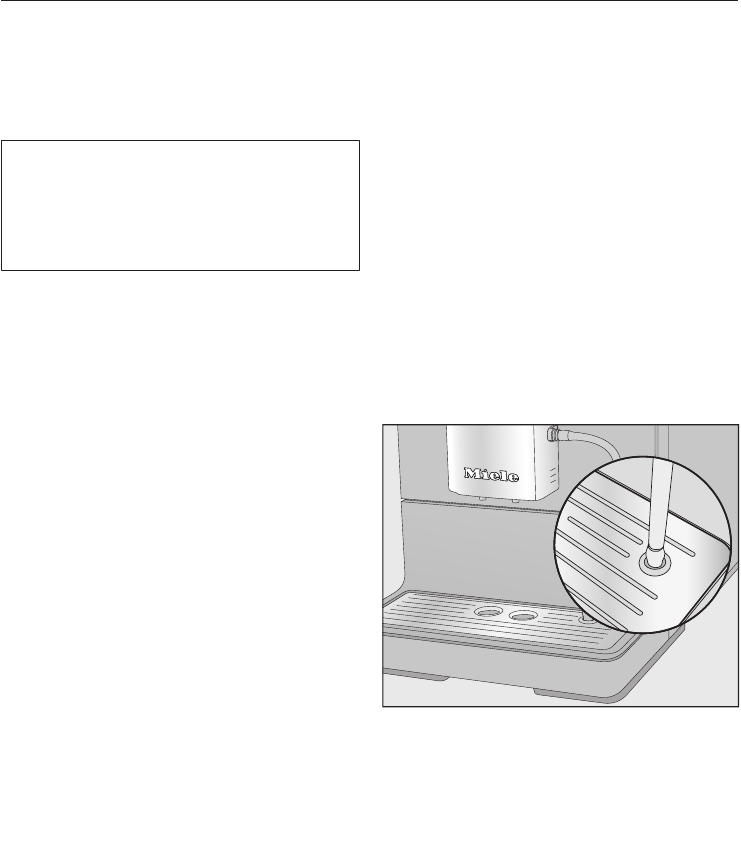
Cleaning and care
52
Rinsing the machine
You can rinse the water and coffee
pipework of the coffee machine
manually.
If coffee has been dispensed, the
coffee machine will rinse the coffee
pipework automatically before
switching off. This removes any
residual coffee grounds.
Touch .
Select Maintenance and touch OK.
Select Rinse appliance and touch OK.
The pipework will now be rinsed
through.
You may also be prompted to insert the
end of the milk tube into the drip tray.
Rinsing the milk pipework
Milk residues can block the milk
pipework. The milk pipework should
therefore be rinsed regularly. If a drink
has been made using milk, the prompt
to insert the end of the milk tube into
the drip tray will appear at the latest
when you switch the machine off.
You can also rinse the milk pipework
manually.
Touch .
Select Maintenance and touch OK.
Select Rinse milk pipework and touch
OK.
When prompted, place the end of the
milk tube into the right-hand aperture
in the drip tray.
Touch OK.
The milk pipework will now be rinsed.
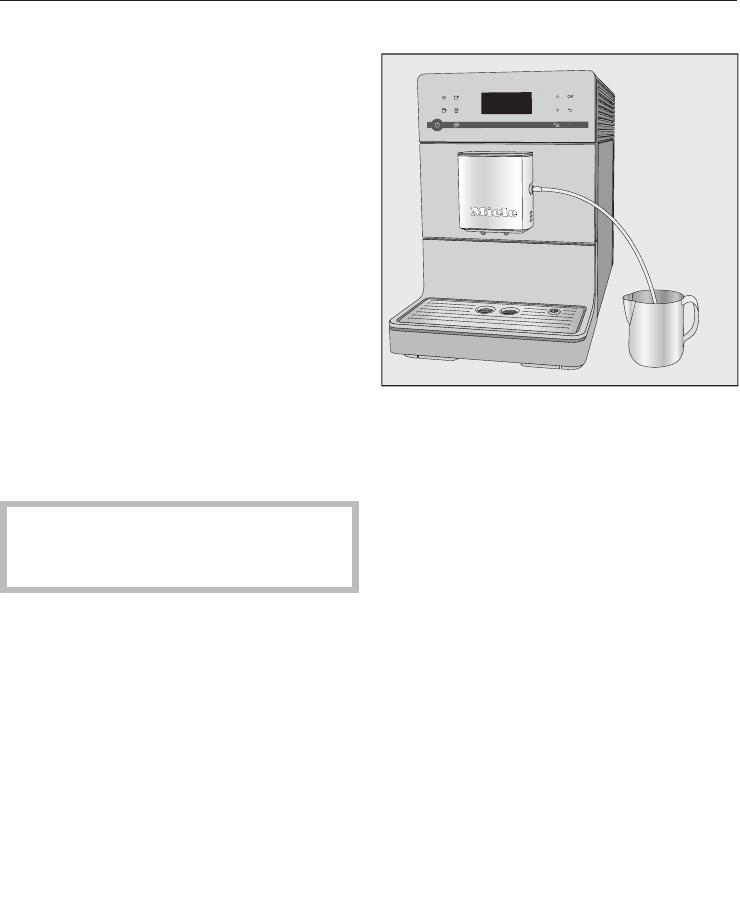
Cleaning and care
53
Cleaning the milk pipework
using the maintenance
programme
For optimal cleaning results, we
recommend Miele Cleaning Agent for
milk pipework. The Cleaning Agent for
milk pipework has been specially
developed for use with Miele coffee
machines and prevents subsequent
damage.
It is available to order via the Miele
webshop or directly from Miele (see the
end of this booklet for contact details).
The Clean milk pipework maintenance
programme lasts for approx.5minutes.
Touch .
Select Maintenance and touch OK.
The cleaning process cannot be
cancelled. It must be completed
through to the end.
Select Clean milk pipework and touch
OK.
The process will start.
Follow the instructions in the display.
Place milk pipe in cleaning agent will
appear in the display.
Preparing the cleaning solution:
Dissolve the cleaning agent in a
container with 200ml of lukewarm
water. Stir the solution with a spoon
until the powder has fully dissolved.
Carrying out the cleaning process:
Place the container next to the
machine and hang the milk tube in
the solution. Make sure it is placed
sufficiently far into the cleaning
solution.
Touch OK.
Follow the further instructions given
in the display.
The cleaning process is finished at the
end of the rinsing cycle.
Tip: Flush any residual cleaning agent
out of the milk pipework with running
water.

Cleaning and care
54
Degreasing the brew unit and
cleaning inside
Depending on the natural oil content of
the coffee used, the brew unit can
become blocked quite quickly. It must
be degreased regularly in order to
ensure aromatic coffee and trouble-free
operation of the coffee machine.
We recommend using Miele cleaning
tablets to clean the brew unit. These
have been specially developed for use
with Miele coffee machines and prevent
subsequent damage.
Miele cleaning tablets can be ordered
via the Miele webshop, from Miele (see
back cover for contact details) or from
your Miele dealer.
The maintenance programme for
degreasing the brew unit lasts for
approx.15minutes.
After 200 portions have been
dispensed, Degrease the brew unit and
clean inside the machine will appear in the
display.
TouchOK to confirm the message.
This notification appears at regular
intervals. Once the maximum possible
number of beverage preparations has
been reached, the coffee machine is
locked
You can switch the coffee machine off if
you do not want to carry out the
cleaning programme at this time.
However, you will be not be able to
make any more drinks until the brew
unit has been degreased.
Start “Degreasing brew unit”
You need 1 Miele cleaning tablet to
degrease the brew unit.
Touch .
Select Maintenance and touch OK.
Select Degrease the brew unit.
The cleaning process cannot be
cancelled. It must be completed
through to the end.
Touch OK.
The process will start.
Follow the instructions in the display.
Cleaning the brew unit and interior
Clean the brew unit by hand only
under warm running water. Do not
use washing-up liquid or any other
cleaning agent. The moving parts of
the brew unit are lubricated. Cleaning
agents and washing-up liquid will
damage the brew unit.
To ensure good tasting coffee and to
prevent the formation of microbes in
the machine, remove and clean the
brew unit under running water once a
week.
Rinse the brew unit by hand and clean inside
the machine will appear in the display.
Open the service panel.

Cleaning and care
55
Press and hold the button under the
brew unit handle and, whilst doing
so, turn the handle to the left.
Carefully pull the brew unit out of the
coffee machine.
When you have removed the brew
unit, do not change the position of
the handle on the brew unit.
Clean the brew unit by hand under
warm running water without using
cleaning agent or washing-up liquid.
Wipe any remaining coffee off the two
filters (see arrows).
Dry the funnel to prevent ground
coffee sticking to it the next time a
coffee is made.
Make sure you regularly remove any
damp ground coffee residues to
prevent the build-up of mould.
Clean the inside of the coffee
machine. Make sure that the areas
highlighted in the illustration are
cleaned especially well.
Tip: Use your vacuum cleaner to
remove dry ground coffee residues.
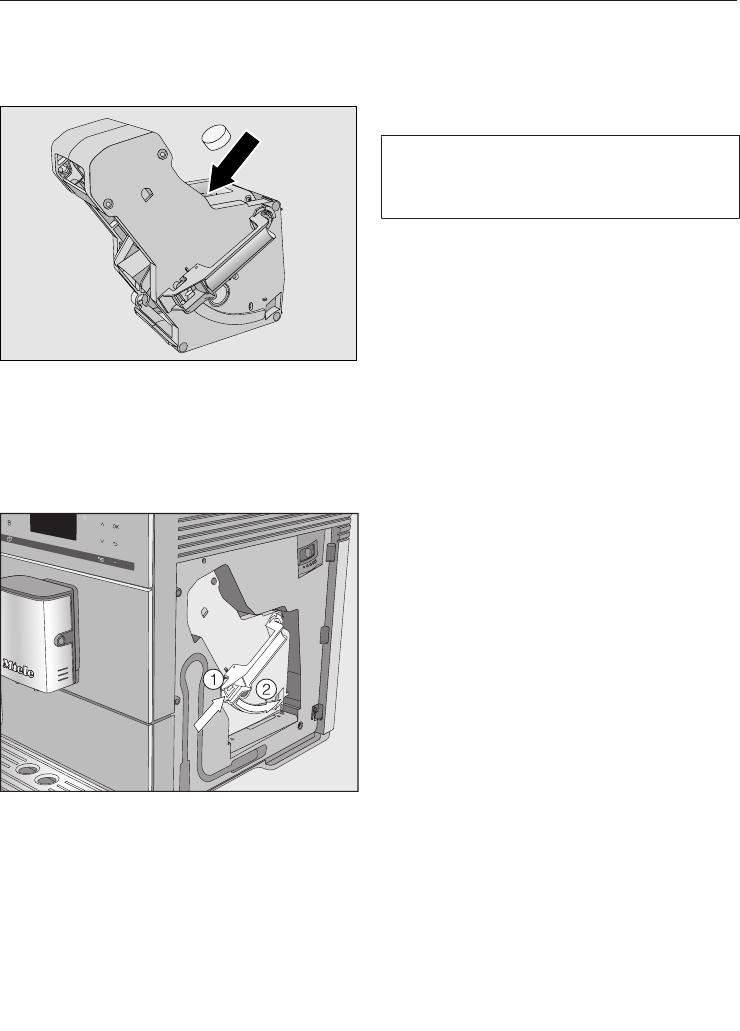
Cleaning and care
56
Insert the brew unit with a cleaning tab in it
and close the machine will appear in the
display.
Drop a cleaning tablet into the top of
the brew unit (arrow).
Push the brew unit with cleaning
tablet back into the coffee machine,
making sure it goes in straight.
Press the button under the handle of
the brew unit and, whilst doing so,
turn the handle anti-clockwise.
Close the machine.
Follow the further instructions given
in the display.
The cleaning process is finished when
rinsing has finished.
Degrease the brew unit when
prompted to do so.
No drinks can be made and Degrease
the brew unit appears in the display.
The maintenance programme cannot
be cancelled. The process has to be
carried through to the end.
TouchOK.
The maintenance programme will then
start.

Descaling the machine
57
Warning. When descaling the
machine, cover delicate surfaces and
natural flooring to prevent damage
from splashes of descaling solution.
Ensure that any splashes of
descaling solution are wiped up
immediately.
Limescale builds up in the coffee
machine through use. How often the
machine needs to be descaled will
depend on the water hardness level in
your area. It should be descaled
regularly to ensure that it functions
correctly.
The machine will guide you through the
descaling process. Various messages
will appear in the display, e.g. you will
be prompted to empty the drip tray or
fill the water container.
Descaling must be carried out. The
process takes approx.15minutes.
The coffee machine prompts you when
it needs to be descaled. No. of uses
until appliance needs descaling: 50 will
appear in the display. The remaining
number of drinks that can be made
before descaling will now show in the
display after each drink is made.
Confirm the message with OK.
When the number of remaining portions
reaches 0, the coffee machine will lock
out.
You can switch the coffee machine off if
you do not want to carry out the
descaling programme at this point in
time. You can not make any drinks until
the machine has been descaled.
Descaling after prompt
appears in the display
Descale the appliance appears in the
display.
The descaling process cannot be
cancelled once it has started. The
process has to be completed through
to the end.
TouchOK.
The process will start.
Follow the instructions in the display.
When Fill water container with descaling
agent and lukewarm water up to the
symbol and place in the appliance appears
in the display, proceed as follows.
Make up the descaling solution
We recommend using Miele descaling
tablets for optimum results.
These have been specially developed
for use with Miele coffee machines and
prevent subsequent damage.
Other descaling agents, which
contain other acids besides citric
acid and/or other undesirable
substances, such as chlorides for
example, could damage the coffee
machine. Moreover, the descaling
effect required could not be
guaranteed if the descaling solution
was not of the appropriate
concentration.
Miele descaling tablets are available to
order via the Miele webshop, from Miele
(see back cover for contact details) or
from your Miele dealer.

Descaling the machine
58
You will need one descaling tablet to
descale the machine.
Fill the water container to the
symbol with lukewarm water.
Place one descaling tablet in the
water.
Follow the instructions for the mixing
ratio carefully. It is important that you
do not fill the water container with
too much or too little water.
Otherwise the descaling process will
be cancelled prematurely.
Carrying out descaling
Push the water container back into
the appliance.
Follow the further instructions given
in the display.
When Rinse the water container and fill with
fresh tap water up to the symbol
appears in the display:
Remove the water container and
rinse it thoroughly with clean water.
Ensure that no descaling solution
residue remains in the water
container. Fill the water container to
the symbol with fresh tap water.
The cleaning process is finished at the
end of the rinsing cycle. You can now
make drinks again.
Ensure that any splashes of
descaling solution are wiped up
immediately. Otherwise surfaces can
be damaged.
Descaling when not prompted
by a message
Touch .
Select Maintenance and touch OK.
Select Descale the appliance.
Descaling cannot be cancelled once it
has started. It must be completed
through to the end.
Touch OK.
The descaling process will now start.

Transporting the machine
59
If you are not going to use the coffee
machine for an extended period of time,
e.g. whilst on holiday, or if it needs to
be moved, a number of procedures will
need be carried out to ensure its safety.
– Empty and clean the coffee bean
container
– Empty and clean the water container
– Evaporate the coffee machine
– Clean the inside of the machine
– Pack the machine securely
Evaporating the coffee
machine
The coffee machine should be
evaporated before it is stored for a long
period of time or transported any
distance - particularly at temperatures
below freezing.
Evaporating means removing all water
from the system. This prevents water
and frost damage to the machine.
Switch the coffee machine on with
the On/Off sensor.
Touch .
Touchtwice.
Empty the system? will appear in the
display.
Select Yes and touch OK.
Follow the instructions in the display.
Caution! Danger of burning and
scalding on the dispensing spouts.
Hot steam is discharged.
The evaporation process is finished
when Prog. finished appears in the
display and the display then goes out.
Switch off the machine and unplug it
to disconnect it from the power
supply.
Clean the drip tray and waste
container.
Packing the machine
The coffee machine should only be
packed when it is clean and dry.
Residues of coffee grounds can cause
scratches on surfaces. Coffee and milk
residues or water can cause a build-up
of bacteria.
Use the original packaging including
polystyrene blocks to pack the coffee
machine.
Also pack the operating instructions so
that they are available when the coffee
machine is next used.

Problem solving guide
60
Many malfunctions and faults that can occur in daily operation can be easily
remedied. Time and money will be saved because a service call will not be
needed.
The following guide may help you to find the reason for a malfunction or a fault,
and to correct it.
Messages in the display
Error messages must be confirmed with OK, otherwise the message can
reappear in the display even though the problem has been remedied.
Follow the instructions which appear in the display to remedy the problem.
If after this, the fault message appears in the display again, contact Miele Service.
Problem Cause and remedy
F1, F2,
F80, F82
There is an internal fault.
Switch the coffee machine off with the On/Off
sensor. Wait for approx.onehour before
switching it back on again.
F41, F42, F74, F77, F235,
F236
There is an internal fault.
Switch the machine off with the On/Off sensor.
Wait for approx.twominutes before switching it
back on again.
F10, F17 No water or very little water is being drawn in.
Remove the water container, fill it with fresh tap
water and replace it.
Carefully clean the surface the water container sits
on, and the casing walls adjacent to the water
container. Dry these surfaces thoroughly.
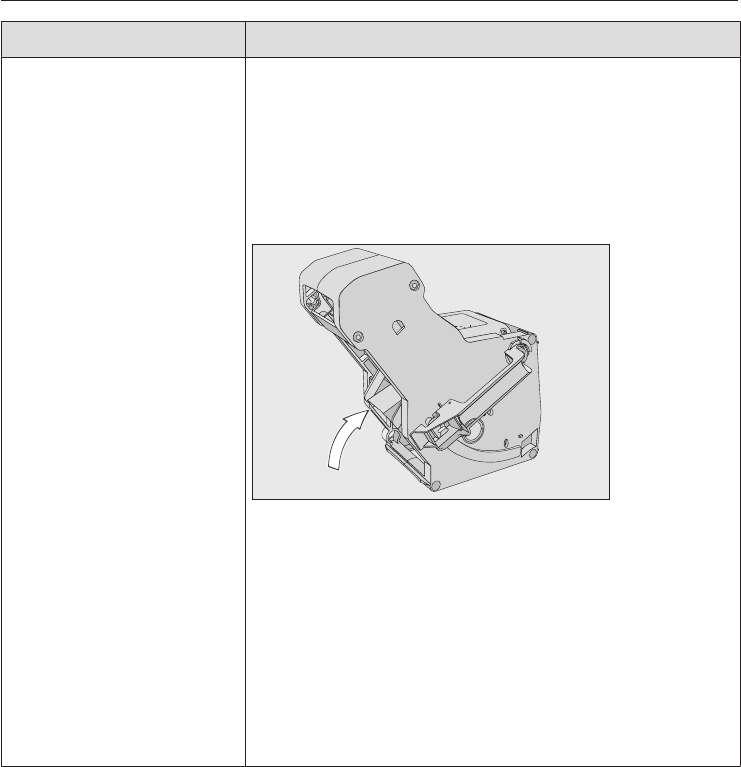
Problem solving guide
61
Problem Cause and remedy
F73 or
Check the brew unit
The brew unit cannot be positioned correctly.
Switch the machine off with the On/Off sensor.
Switch off at the wall socket and remove the plug.
Wait for two minutes before inserting the plug
back in the socket and switching on.
Remove the brew unit and rinse under warm
running water.
Push the coffee ejector of the brew unit into the
correct position.
Do not fit the brew unit. Close the service panel
and switch the coffee machine on with the On/
Off sensor.
This will initialise the brew unit motor and put it back
into the start position.
When Insert the brew unit appears in the display, put
the brew unit back in the machine. Close the
service panel.

Problem solving guide
62
Problem Cause and remedy
Too much ground coffee There is too much ground coffee in the coffee chute.
The brew unit cannot compact ground coffee if more
than two level spoonfuls of ground coffee are added
to the coffee chute. The ground coffee will be emptied
into the waste container and the fault message will
appear in the display.
Switch the machine off with the On/Off sensor.
Remove and clean the brew unit by hand (see
“Cleaning and care - Degreasing the brew unit and
cleaning the interior”).
Remove the ground coffee inside the coffee
machine, e.g. with a vacuum cleaner.
Place a maximum of 12g of coffee in the ground
coffee chute.

Problem solving guide
63
Unusual performance of the coffee machine
Problem Cause and remedy
The display remains
dark after the coffee
machine has been
switched on using the
On/Off sensor.
The On/Off sensor was not touched for long
enough.
Touch the depression in the middle of the On/Off
sensor for at least three seconds.
The plug is not inserted in the socket correctly.
Insert the plug into the socket correctly and switch
on.
The mains fuse has tripped due to a problem with the
coffee machine, the electricity supply or another
appliance.
Switch the coffee machine off at the wall socket
and unplug it.
Contact a qualified electrician or Miele Service.
The coffee machine
switches off suddenly.
The switch-off time programmed using the timer has
been reached.
If required, you can select a new switch-off time
(see “Settings - Timer”).
The plug is not inserted in the socket correctly.
Insert the plug into the socket correctly and switch
on.
The sensors do not
react to touch.
The coffee machine
cannot be operated.
There is an internal fault.
Disconnect the machine from the power supply by
removing the plug from the socket.
The display is hard to
see or not able to be
read.
The display brightness has been set too low.
Change this setting (see “Settings”).
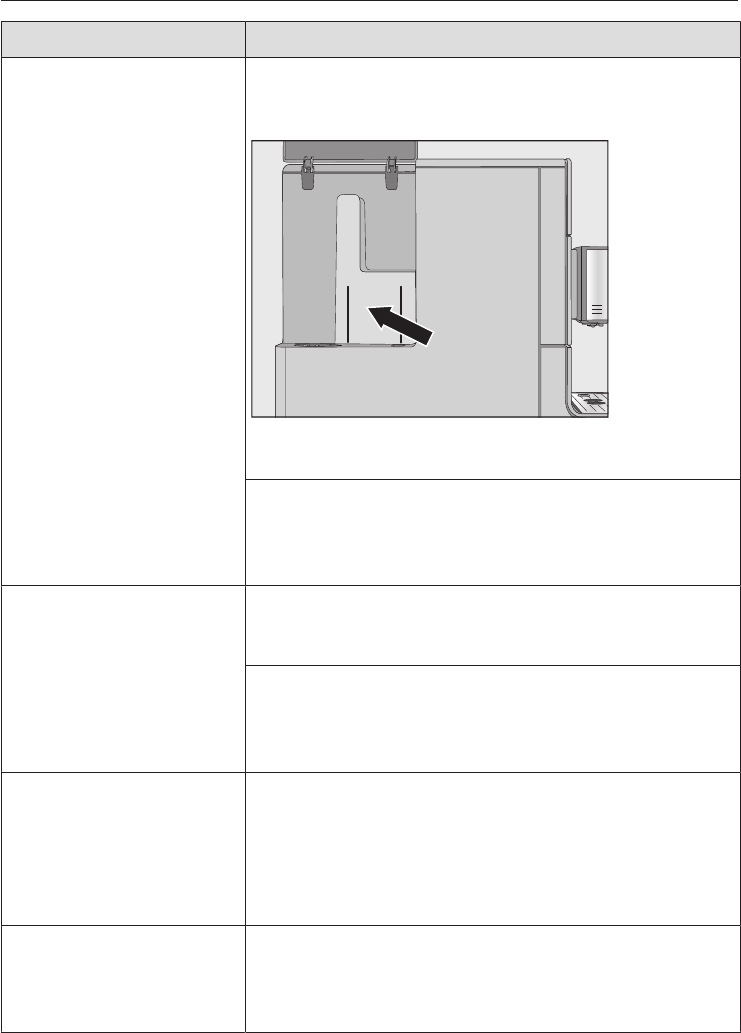
Problem solving guide
64
Problem Cause and remedy
The water container is
empty. Fill and replace the
water container has not
appeared in the display.
Droplets of water have settled between the water
container and the side walls of the casing, or this area
is damp (see illustration).
Dry these surfaces thoroughly. Take the water
container out to refill it with water.
There is too much residual water on the inside walls
of the water container, e.g. a biofilm has developed.
Or the water container has a build-up of limescale.
Clean the water container every day.
Fill and replace the water
container appears in the
display even though the
water container is full
and in the machine.
The water container is not in the correct position.
Remove the water container and push it back in
again.
The water container was not correctly filled and
refitted for descaling.
Fill the water container to the descaling symbol
and restart the descaling programme.
After switching on the
machine the message
Empty the drip tray and the
waste container appears
even though they are
both empty.
This is not a fault.
The drip tray and waste container were probably not
emptied after making the last coffee, or the internal
counter was not reset.
Remove the drip tray and waste container from the
machine and empty them.
Neither milk nor milk
froth comes out of the
central spout.
The milk pipework is blocked.
Clean the central spout, taking particular care to
clean the cappuccinatore and milk pipework
connections carefully with the cleaning brush.

Problem solving guide
65
Problem Cause and remedy
Empty the drip tray and the
waste container appears
in the display, even
though the drip tray has
been emptied.
The drip tray is not positioned correctly in the
machine.
Push the drip tray in as far as it will go.
Make sure that the lower panel is sitting on the
drip tray correctly.
Insert the drip tray and the
waste container appears
in the display even
though both are fitted.
The drip tray is not in the correct position and is
therefore not detected.
Empty the drip tray and the waste container.
Reassemble all parts and push the drip tray back
as far as it will go in the coffee machine.
The drip tray or waste
container is full or
overflowing, although
they have been emptied
following each
reminder.
This is not a fault.
The drip tray and waste container were probably
removed or the machine was opened without the drip
tray and waste container being emptied. When the
drip tray is removed or the machine opened, the
internal counter for emptying the drip tray and waste
container is automatically reset.
Remove the drip tray and waste container from the
machine and empty them.
Fill the bean container
appears in the display
even though the bean
container has just been
filled.
This is not a fault.
Confirm the message with OK.
Insufficient coffee beans are getting into the grinder.
Have you used a dark roast?
This type of coffee bean is often more oily. These oils
can cling to the inside of the coffee bean container
and hinder the flow of beans.
Make a coffee and observe whether the coffee
beans drop into the coffee bean container.
Clean the coffee bean container more often if you
are using a darker, more oily bean.
Try other types of coffee bean which are less oily.
The coffee machine
does not rinse itself
when turned on.
This is not a fault.
If the coffee machine is already at operating
temperature, rinsing will not take place.

Problem solving guide
66
Problem Cause and remedy
Coffee dispensing is
repeatedly interrupted
and the message Fill the
bean container appears in
the display.
This is not a fault.
The brew unit has not detected the ground coffee.
The coffee may be too finely ground or there may not
be enough of it. Usually this is because the grinder is
set too fine and the amount set is insufficient.
Confirm the message with OK.
If the coffee is too strong for you or tastes bitter, try a
different type of coffee beans.
If the display appears with all types of coffee:
Set the grinder to a coarser setting (see “Grinder
setting”).
Check the amounts of coffee set for all coffee
drinks (see “Amount of coffee”). Select a larger
amount of coffee if necessary.
Don't forget to check any drinks changed in “Profiles”.
If the message only appears when dispensing certain
drinks:
Check the amount of coffee set for this drink (see
“Amount of coffee”). Select a larger amount of
coffee.
You may also need to set a coarser grinder setting.
The descaling process
was started by mistake.
The descaling process cannot be stopped once the
“OK” sensor has been touched.
Descaling must be continued through to completion.
This is a safety precaution to make sure the machine
is descaled correctly. This is important for the
longevity and functional efficiency of your coffee
machine.
Descale the coffee machine (see “Descaling”).

Problem solving guide
67
Problem Cause and remedy
The milk sputters when
it is dispensed. Hissing
noises can be heard
when milk is being
heated up or frothed.
Although the milk
should be frothed, only
hot milk comes out of
the main dispenser.
The milk temperature is too high. Good milk froth can
only be achieved with cold milk (below 10°C).
Check the temperature of the milk.
The central dispenser with integrated cappucinatore is
not correctly fitted and is taking in air. Or the spouts
are blocked.
Check whether the central spout has been
assembled correctly. Make sure that all parts are
tightly connected to one another.
If necessary, clean the central spout.
The milk pipework, connections or the intake tube on
the milk flask are blocked.
Clean all parts thoroughly.
The steam jet on the central spout has a blockage.
Push the cleaning brush a max. of 1cm into the
steam jet.
Clean the steam jet with the cleaning brush.
Coffee grounds have
settled on the lid of the
drip tray and in the
interior around the brew
unit.
This is not a fault.
The movement of the brew unit during the brewing
process can cause some ground coffee to fall around
it. The type of beans used, the fineness of the ground
coffee and the amount of coffee ground also affect
the amount. Important! Clean the inside of the coffee
machine regularly to prevent mould etc.

Problem solving guide
68
Problem Cause and remedy
The underside of the
coffee bean container
cover is very damp
Drops of water are
visible.
Too many drinks have been made one after the other
and the ground coffee chute is not closed or not
properly closed. Steam has risen up from the brew
unit via the ground coffee chute and condensed
under the cover.
Replace the lid on the ground coffee chute making
sure it is properly sealed.
Water from making
coffee has collected on
the worktop underneath
the coffee machine.
This is not a fault. Water can get under the machine
when the drip tray is removed.
Clean the surfaces underneath the coffee machine
regularly.
The display lights up
but the coffee machine
does not heat up and no
drinks are made.
The coffee machine
cannot be turned off
with the On/
Offsensor.
Demo mode for demonstrating the coffee machine in
the showroom has been activated.
Deactivate demo mode (see “Settings – Demo
mode”)

Problem solving guide
69
Unsatisfactory results
Problem Cause and remedy
The coffee is not hot
enough.
The cup has not been pre-heated.
The smaller the cup and the thicker its sides, the
more important it is to pre-heat it.
Pre-heat the cup, for example, with hot water.
The brewing temperature has been set too low.
Set a higher brewing temperature.
The filters in the brew unit are blocked.
Remove the brew unit and clean by hand
Degrease the brew unit.
The heating-up time is
getting longer, the
amount of water being
dispensed is incorrect
and the coffee machine
is not performing
properly. Coffee flows
very slowly out of the
central spout.
The coffee machine needs descaling.
Descale the coffee machine.
Coffee is not flowing
out of the central spout.
Or coffee is only being
dispensed via one
spout.
The central spout has a blockage.
Clean the coffee pipework (see "Cleaning and care
- Rinsing the machine).
If there is still no coffee coming out, or coffee is
only coming out of one side, clean the dispensing
spouts with the cleaning brush.
The consistency of the
milk froth is
unsatisfactory.
The milk temperature is too high. Good milk froth can
only be achieved when cold milk (below 10°C) is
used.
Check the temperature of the milk in the milk flask.
The milk pipework is blocked.
Clean the central spout with integrated
cappuccinatore and the milk pipework with the
cleaning brush supplied.

Problem solving guide
70
Problem Cause and remedy
The coffee grinder
makes a louder noise
than usual.
The coffee bean container has become empty during
the grinding process.
Fill the container with fresh beans.
There may be stones in amongst the coffee beans.
Switch the coffee machine off immediately. Call
Miele.
The coffee flows too
quickly into the cup.
The coffee is too coarsely ground.
Set the grinder to a finer setting (see “Grinder
setting”).
The coffee trickles too
slowly into the cup.
The coffee is too finely ground.
Set the grinder to a coarser setting (see “Grinder
setting”).
The crema on the
coffee or espresso is
not as it should be.
The grinder setting is not correct.
Set the grinder to a finer or coarser setting (see
“Grinder setting”).
The brewing temperature is too high for this type of
coffee.
Set a lower brewing temperature (see “Brewing
temperature”).
The coffee beans are stale.
Add fresh coffee beans to the coffee bean
container.
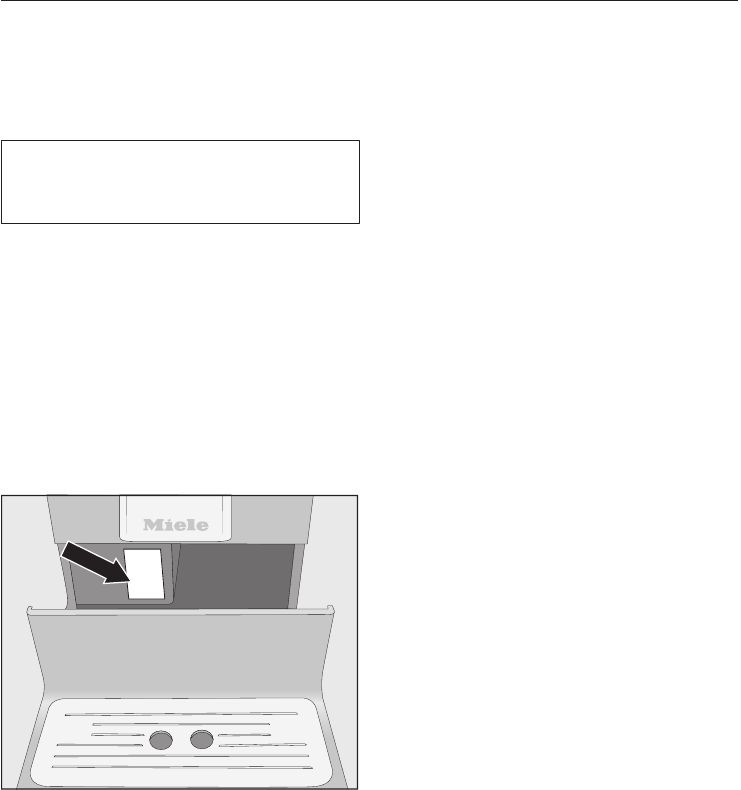
After sales service
71
Contact in case of malfunction
In the event of any faults which you
cannot remedy yourself, please contact
your Miele Dealer or Miele Service.
Contact information for Miele Service
can be found at the end of this
document.
Please note that telephone calls may be
monitored and recorded for training
purposes and that a call-out charge will
be applied to service visits where the
problem could have been resolved as
described in this booklet.
Please quote the model and serial
number of your appliance when
contacting Miele. This information can
be found on the data plate.
Warranty
For information on the appliance
warranty specific to your country please
contact Miele. See back cover for
address.
In the UK, your coffee machine
warranty is valid for 2 years from the
date of purchase. However, you must
activate your cover by calling 0330 160
6640 or registering online at
www.miele.co.uk.

Saving energy
72
The following tips can help you save
energy and money as well as care for
the environment:
– Operate the coffee machine in “Eco
mode” (default setting).
– Energy consumption may increase if
you change the settings for the
“timers”.
This setting uses more energyappears in
the display.
– Switch the coffee machine off with
the On/Off sensor if it is not going
to be used for a while.
– Change the setting for the “Switch off
after” timer to 15 minutes. The coffee
machine will then switch itself off
15minutes after the last drink was
made or a sensor was touched.

Electrical connection
73
Before connecting the appliance, make
sure that the connection data on the
data plate (voltage and frequency)
match the mains electricity supply.
This data must correspond in order to
avoid the risk of damage to the
machine. Consult a qualified electrician
if in any doubt.
The connection data is given on the
data plate. The data plate can be seen
on the left-hand side when the drip tray
is pulled out.
The machine is supplied with a mains
cable with moulded plug for connection
to a 50 Hz 220-240V supply.
The coffee machine must be connected
to the mains supply via a suitable
switched socket with earthing contact.
Connection must comply with national
and local safety regulations (BS 7671 in
the UK).
The fuse rating must be at least 10 A.
The socket should be next to the
appliance and easily accessible.
Do not connect the machine to the
mains electricity supply by a multi-
socket adapter or an extension lead.
These do not guarantee the safety of
the appliance (fire risk).
Do not connect the machine to an
inverter such as those used with an
autonomous energy source, e.g. solar
power. When switched on, peak loads
in the system can cause the safety
switch-off mechanism to be triggered.
This can damage the electronic unit.
The machine must not be used with so-
called energy saving plugs. These
reduce the amount of energy supplied
to the machine, causing it to overheat.
If the connection cable is faulty, it may
only be replaced by a qualified
electrician in order to avoid a hazard.

Installation
74
Danger of overheating
Please ensure that there is adequate
ventilation around the machine.
Do not cover the machine with tea
towels or similar objects whilst it is in
use.
Danger of overheating
If the coffee machine is installed
behind a kitchen furniture door, it
may only be used with the furniture
door open.
Do not close the furniture door while
the coffee machine is in use.
Please observe the following installation
instructions:
– The location of the machine must be
dry and well ventilated.
– The ambient temperature of the room
in which the machine is used must be
between 10°C and 38°C.
– The machine must be set up on a
level surface. The surface must be
water resistant.
If the machine is installed in a niche, the
niche must provide the following
minimum dimensions:
Height 510mm
Width 450mm
Depth 575mm
When setting up the machine: make
sure that the service panel can be
fully opened so that the brew unit
can be removed with ease when
required.
The machine must be set up in the
niche such that it sits flush with the
front edge of the niche.
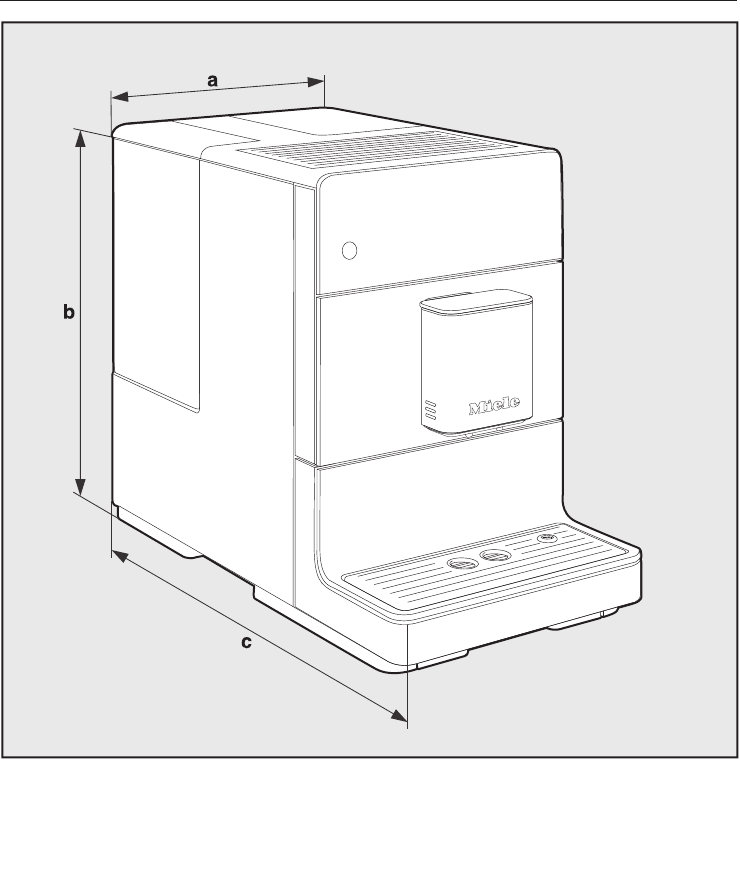
Dimensions
75
a = 241 mm
b = 360 mm
c = 460 mm

Technical data
76
Current draw in standby mode
(default setting)
<0.5Watt
Pump pressure: max.15bar
Through-flow heater: 1stainless steel thermo block
Dimensions (W x H x D): 241x360x460mm
Net weight: 9.48kg
Connection cable length: 120cm
Water container
capacity:
1.3l
Bean container
capacity:
200g
Waste container
capacity:
max. 6portions of coffee grounds
Central spout: Height adjustable from 80-135mm
Grinder: Conical stainless steel grinder
Grinder setting: 5settings
Ground coffee amount: max.12g

United Kingdom
Miele Co. Ltd.
Fairacres, Marcham Road
Abingdon, Oxon, OX14 1TW
Customer Contact Centre Tel: 0330 160 6600
E-mail: [email protected]
Internet: www.miele.co.uk
Australia
Miele Australia Pty. Ltd.
ACN 005 635 398
ABN 96 005 635 398
1 Gilbert Park Drive
Knoxfield, VIC 3180
Tel: 1300 464 353
Internet: www.miele.com.au
Miele (Shanghai) Trading Ltd.
1-3 Floor, No. 82 Shi Men Yi Road
Jing' an District
200040 Shanghai, PRC
Tel: +86 21 6157 3500
Fax: +86 21 6157 3511
E-mail: [email protected],
Internet: www.miele.cn
China
41/F - 4101, Manhattan Place
23 Wang Tai Road
Kowloon Bay, Hong Kong
Tel: (852) 2610 1025
Fax: (852) 3579 1404
Email:
Website: www.miele.hk
Miele (Hong Kong) Limited
Miele India Pvt. Ltd.
Ground Floor
Copia Corporate Suites
Plot No. 9, Jasola
New Delhi - 110025
Tel: 011-46 900 000
Fax: 011-46 900 001
E-mail: [email protected]
Internet: www.miele.in
India
Miele Ireland Ltd.
2024 Bianconi Avenue
Citywest Business Campus
Dublin 24
Tel: (01) 461 07 10
Fax: (01) 461 07 97
E-Mail: [email protected]
Internet: www.miele.ie
Ireland
Malaysia
Miele Sdn Bhd
Suite 12-2, Level 12
Menara Sapura Kencana
Petroleum
Solaris Dutamas No. 1
Jalan Dutamas 1
50480 Kuala Lumpur, Malaysia
Phone: +603-6209-0288
Fax: +603-6205-3768
Miele New Zealand Limited
IRD 98 463 631
Level 2, 10 College Hill
Freemans Bay, Auckland 1011
New Zealand
Tel: 0800 464 353
Internet: www.miele.co.nz
New Zealand
Miele Pte. Ltd.
163 Penang Road
# 04 - 03 Winsland House II
Singapore 238463
Tel: +65 6735 1191
Fax: +65 6735 1161
E-Mail: [email protected]
Internet: www.miele.sg
Singapore
Miele (Pty) Ltd
63 Peter Place, Bryanston 2194
P.O. Box 69434, Bryanston 2021
Tel: (011) 875 9000
Fax: (011) 875 9035
E-mail: [email protected]
Internet: www.miele.co.za
South Africa
Miele Appliances Ltd.
Gold & Diamond Park
Office No. 6-217
Sheikh Zayed Road
P.O. Box 11 47 82 - Dubai
Tel. +971 4 3044 999
Fax. +971 4 3418 852
800-MIELE (64353)
E-Mail: [email protected]
Website: www.miele.ae
United Arab Emirates
Manufacturer:
Miele & Cie. KG, Carl-Miele-Straße 29, 33332 Gütersloh, Germany
K.E. & Kingstone Co., Ltd.
6th Fl., No. 120, Sec. 2
Jianguo N. Rd.
Taipei, Taiwan
TEL: +886 2 2502-7256
FAX: +886 2 2502-3077
E-mail: [email protected]
Website:
www.kenk.com.tw/ke/miele
Taiwan
Thailand
BHIRAJ TOWER at EmQuartier
43rd Floor Unit 4301-4303
689 Sukhumvit Road
North Klongton Sub-District
Vadhana District
Bangkok 10110, Thailand

M.-Nr. 10 793 020 / 01en-GB
CM5300, CM5400, CM5500
